] 

April 2023
|
Search the FOA website
FOA Home Page
Contact
Us
|
Sign
up for the FOA eMail Newsletter
Privacy Policy
Sections
News
Technical
Worth
Reading Q&A
Training/FiberU
Resoures
Safety
About
|
No April Foolin'
The Ultimate "Joke"
What Do Employers Expect
Improving Your Productivity
Special Safety Notice
4 New FOA Schools Around The World
Updated FOA Schools Map
Latest FOA Book - Fiber Broadband
New Fiber U MiniCourse - Project Management
Fiber Optic Conference For Latin America
More Translations Of FOA Textbooks
Links To Resources On Broadband
Newsletter Sections
Click
on any link to jump to that section
News
IMSA/FOA CFOS/D Course
Metcalfe Wins Turing Award
TIA BEAD Success Summit
ISE Expo 2023
Wireless Infrastructure Statistics
Telegeography Submarine Cable Map
FiberWizards Online Programs
Technical
Problems With Micro/HD Cables?
Fiber Begins Journey To Jupiter
A Fishtape That Glows
Managing Projects - Gantt Charts
FOA Color Code Guides
FOA Online Loss Budget Calculator
Worth
Reading Lots of interesting
articles
Q&A
Questions from our readers
Always Interesting!
Training/FiberU
New FOA-Approved Schools,
Fiber U
MiniCourses
more
Resources
New FOA Technical Resources
Safety
About the FOA
FOA Certified Techs:
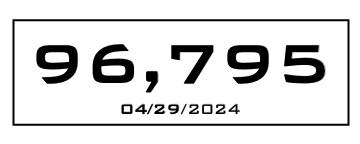
Time
To Renew Your FOA Certifications?
Special offer - 1/3
Off Renewal
Jobs
- See FOA Jobs
Web Page and FOA on

- The FOA Jobs
Web Page has been updated and a new page added
on Using your FOA
Training/Certification to Find the Right Job
in Fiber Optics
Where
Are The Jobs In Fiber Optics? FOA talks about
all the applications for fiber optics, what jobs
involve and the qualifications for the workers in
the field in this YouTube video.
Join The FOA eMail Newsletter
List
Want
to be notified when the FOA Newsletter is updated? Sign
up for the FOA eMail Newsletter. You can
also sign up from your cell phone: text "FOA" to
22828 (usual text message charges apply)
Trademarks:
The FOA CFOT® (Certified Fiber Optic Technician) and
Fiber U® (the FOA online learning site) are
registered trademarks of the FOA.

Want to know more about fiber optics?
Looking for specific information? Here's the largest
technical reference on the web: The
FOA Online Fiber Optic Reference Guide.
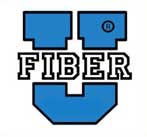
Free online self-study programs
on many fiber optics and cabling topics are
available at Fiber U,
FOA's online web-based training website.
FOA
Reference Books
Available Printed or eBooks
The fiber book is
available in Spanish and French
  
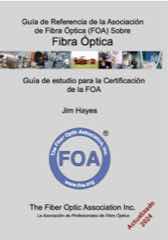
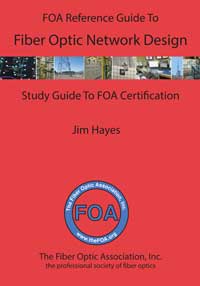 
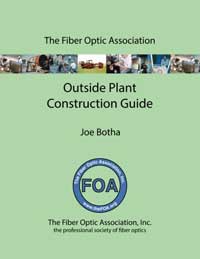 
Lennie
and Uncle Ted's
Guides are now also available as free iBooks on
iTunes.
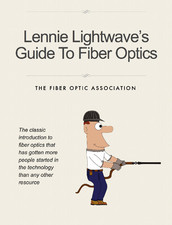

Click on any of
the books to learn more.
- Fiber
Optic Safety Poster to download and
print
FOA Videos on 
FOA
is a member of:




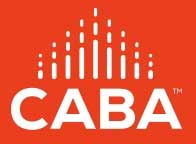
The FOA Newsletter is
edited by Jim Hayes - send your stories, leads,
ideas, comments to <jim @ foa.org>

Search the FOA Website With
DuckDuckGo
Top Stories From The Past FOA Newsletters
- The Archives: Past
Issues.
- Use these links to
read past issues or use FOA's
Custom Search to look for specific
topics on our website.
1/23, 2/23, 3/23, 4/23,
1/22, 2/22, 3/22, 4/22, 5/22, 6/22, 7/22, 8/22, 9/22, 10/22, 11/22, 12/22
1/21, 2/21. 3/21, 4/21, 5/21, 6/21, 7/21, 8/21, 9/21, 10/21,
11-12/21,
1/20,
2/20,
3/20.
4/20,
5/20,
6/20,
7/20,
8/20,
9/20,
10/20,
11/20,
12/20,
1/19,
2/19,
3/19,
4/19, 5/19, 6/19, 7/19, 8/19, 9/19,
10/19,
11/19,
12/19
1/18,
2/18,
3/18, 4/18,
5/18, 6/18, 7/18, 8/18, 9/18, 10/18,
12/18.
1/17, 2/17, 3/17, 4/17, 5/17, 6/17,
7/17,
8/17,
9/17,
10/17, 11/17,
12/17
1/16, 2/16, 3/16,
4/16,
5/16,
6/16,
7-8/16,
9/16,
10/16,
11/16,
12/16
1/15,
2/15,
3/15,
4/15,
5/15,
6/15,
7/15,
8/15,
9/15 ,
10/15,
11/15
, 12/15
1/14,
2/14,
3/14,
4/14,
5/14,
6/14,
7/14,
8/14,
9/14,
10/14,
11/14,
12/14
1/13,
2/13,
3/13,
4/13,
5/13, 6/13,
7/13,
8/13,
9/13,
10/13,
11/13,
12/13
1/12
, 2/12,
3/12,
4/12,
6/12,
7/12,
8/12,
9/12,
10/12,
11/12,
12/12
1/11 ,
2/11,
3/11,
4/11,
6/11,
7/11,
8/11,
9/11, 10/11,
11/11,
12/11,
1/10 ,
2/10,
3/10,
4/10,
05/10,
07/10,
08/10,
09/10,
10/10,
11/10
1/09 ,
2/09,
3/09,
04/09,
05/09,
07/09,
08/09,
09/09,
10/09, 11/09,
12/09
1/08 , 2/08, 3/08, 4/08, 5/08, 6/08, 7/08, 8/08, 09/08, 10/08, 11/08, 12/08
12/07 , 11/07, 10/07, 09/07, 08/07, 07/07, 06/07, 05/07, 04/07, 03/07, 2/07, 1/07
12/06 , 11/06, 10/06, 09/06, 8/06, 7/06, 6/06, 5/06, 4/06, 3/06, 2/06, 1/06,
12/05 ,11/05, 10/05, 09/05, 08/05, 07/05, 6/05, 5/05, 4/05, 2/05, 01/05,
12/04 , 10/04, 9/04, 8/04, 7/04, 6/04, 5/04, 4/04, 3/04, 1/04,
12/03 , 11/03 10/03 9/03, 8/03, 7/03, 6/03, 3/03, 10/02 , 8/02, 5/02
Current Issue of FOA
Newsletter
Highlights from the FOA Newsletter in 2022
Multiple bullets hit Xfinity fiber cable, causing outage in Oakland (February 22)
More Thoughts On Broadband For Rural Areas (March 22) (June 22)
Fiber Optics In The Movies - Star Wars Special Effects (March 22)
Fiber Optics Again Helps Find A Famous Shipwreck (April 22)
Thinking About A Fiber Optic Project? Better Get Started Soon (April 22)
AT&T Says Good-bye To Copper (April 22)
More Pole Stories And Photos (May 22)
Why Stop At Gigabits? Let's Design Fiber Networks For Terabits (July 22)
Understanding The Fiber Optic Workforce (August 22)
Does the Infrastructure Investment and Jobs Act (IIJA) truly benefit people in rural America? (September 22)
Can Wireless Compete With Fiber? Satellites? (October 22)
What is Certification/How Do you Learn (November 22)
School Special Issue (with photos) (December 22)
New Fiber U Self Study Programs
Fiber Characterization (for long distance, high speed networks)
Minicourses: Attenuators, Reference Cables, Project Management
December 2022 Special Feature: A Salute To FOA's Schools And Training Organizations
Time To Renew Your
FOA Certifications?
To
keep your FOA certifications active, you need to
renew them when they expire. Now we have a new more
convenient way to renew - an online store at Paypal
- where you can quickly and conveniently use your
PayPal account or your credit card to renew your
certifications.
- You can now renew
with a credit card or PayPal
-
Join FOA On
Social Media

FOA
has 3 LinkedIn Groups
FOA
- official page on LinkedIn - covers FOA, technology and jobs in the fiber optic
marketplace
FOA
Fiber Optic Training - open to all, covers
fiber optic technology and training topics
Grupo
de La Asociación de Fibra Óptica FOA (Español)
|
No April Foolin'
We thought about having a lead article that was an April Fool's joke but
didn't do it. At first we thought about writing an article using ChatGPT, the
AI that everyone's talking about, but our efforts only ended up with a
story about baboons installing fiber, something we thought was insulting
to fiber techs.
We finally decided it was hard to beat the best fiber optic April Fool's
joke, the Google announcement more than a decade ago of their FTTH
program "TiSP" where users did their own FTTH installation by flushing a fiber optic cable down the toilet.
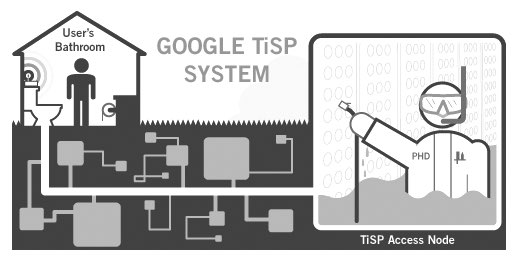
Drawing from the Google TiSP website.
Then this photo showed up in an email newsletter we received this
week. We're not sure if it's supposed to be an April Fool's joke
or maybe one of those
"How many things can you find wrong in this picture" quizzes. Or maybe
the worker climbing up that spindly latter to a mess of wires is just
an example of
bad workmanship and OSHA violations. See Special Safety Notice below.

(If you really like April Fools' Day jokes, The Washington Post has the best list of them for 2023.)
The Ultimate "Joke"
Of course the ultimate "joke" on all of us may have been perpetrated by the
Silicon Valley venture capitalists (VCs) which could cause both a banking
crisis and a recession. These VCs, who obviously had no regard for
anyone but themselves and seemed to not understand the banking business,
took their motto "move fast and break things" and changed it to "move fast and break the banks."
This could be bad timing for broadband. The large amount of federal
money becoming available for broadband projects in underserved and
unserved areas, both urban and rural, has a requirement of private
investment in the project also through a minimum of 25% matching fund requirement.
We also need a lot of private investment for the expansion of
facilities and production by suppliers so they can meet the expected
demand for fiber components in the near future.
Private investment requires banks to loan money, and right now a lot of
banks are very skittish. Plus we have a problem with inflation that
central banks are trying to solve by raising interest rates, which
raises the cost of borrowing.
Then there is the threat of a recession.
(Italics)
CitiBank Weekly Market Update 3/27/23: We believe the US economy is
positioned for a shallow recession. The US economy was already slowing
prior to the present banking crisis. Large sectors of the US economy
will be impacted by changes in the availability and pricing of credit,
in our view. These sectors will see a greater contraction that will have
spillover effects. An overall stall in US growth will follow, along
with a likely mild recession in 2023.
How will all this affect the fiber optic business? We have no idea! We are just concerned. No April Fools!
What Do Employers Expect From A Fiber Optic Tech?
As part of its workforce development program to support their
applications for BEAD broadband funding, the state of Maine commissioned
Camoin Associates to create the Maine Broadband Workforce Strategy Report.
The report included this page of quotes from those interviewed, which
everyone involved in fiber optic workforce development should read
carefully.
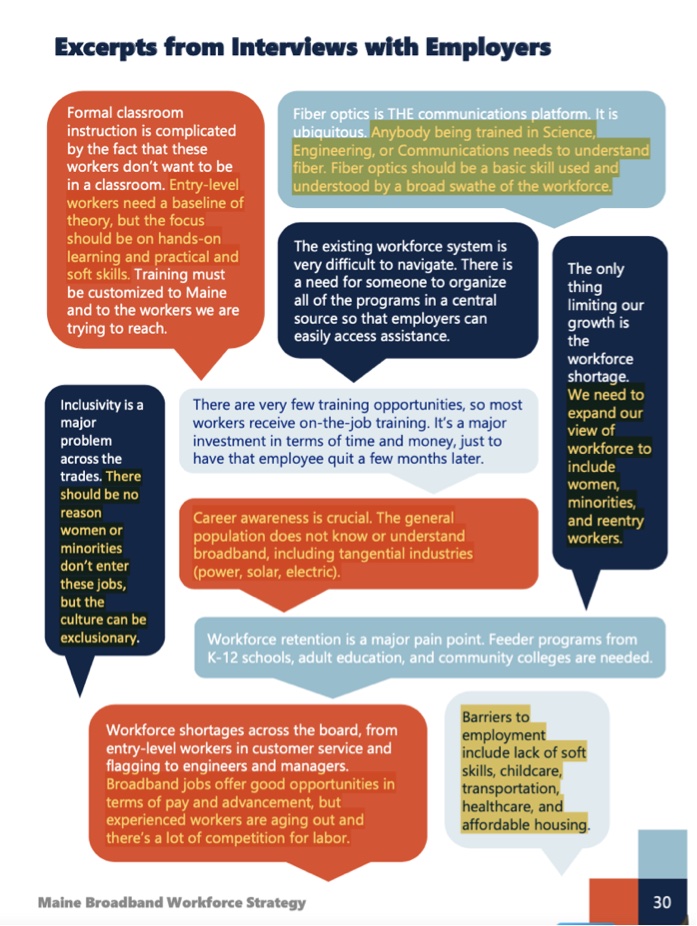
Click on the image for a larger PDF version.
This page is important and repeats what contractors told us at the 2016 Workforce Summit FOA held to get training started to create the workforce needed to build Kentucky Wired.
Here are some of the most important ideas here:
Fiber optics is THE communications platform. It is ubiquitous.
Anybody being trained in Science, Engineering, or Communications needs
to understand fiber. Fiber optics should be a basic skill used and
understood by a broad swathe of the workforce. We should not
think of fiber optics as a niche technology. It is what makes
communications, information technology, security, transportation, the
electrical grid, even traffic control work today. Anyone taking a
science or engineering course should learn about fiber optics and even
science in the early grades need to learn what it is and how it works -
plus it lends itself to some fascinating visual demonstrations!
Entry-level workers need a baseline of theory, but the focus should be on hands-on learning and practical and soft skills.
When FOA started, it was common for fiber optic courses to begin with a
day of optics theory, which no fiber tech would ever need. We said no,
start with some simple demos and explanations of how fiber and fiber
optic communications systems work, then teach tests about fiber optic
cables and installation, cable prep plus splicing and termination,
testing fiber optics - the skills they need to build fiber optic
networks.
We need to expand our view of workforce to include women, minorities,
and reentry workers. There should be no reason women or
minorities don’t enter these jobs, but the culture can be exclusionary.
Barriers to employment include lack of soft skills, childcare,
transportation, healthcare, and affordable housing. These are issues
that need to be addressed, but they are not limited to the fiber optic
workforce, nor are they issues that can be addressed with training. They
are societal and governmental issues.
Workforce retention is a major pain point. There are very few
training opportunities, so most workers receive on-the-job training.
It’s a major investment in terms of time and money, just to have that
employee quit a few months later. This is another issue outside the
scope of job training, but we've heard it many times as an excuse to not
provide workforce training; a rather self-defeating attitude. Some
contractors tie training to employment; where employee training is only
paid for if the employee stays for a fixed length of time. But workers
need to understand the employer-employee relationship and agree to what
is expected from each party.
Workforce shortages across the board, from entry-level workers in
customer service and flagging to engineers and managers. Broadband jobs
offer good opportunities in terms of pay and advancement, but
experienced workers are aging out and there’s a lot of competition for
labor. That's what we're facing today.
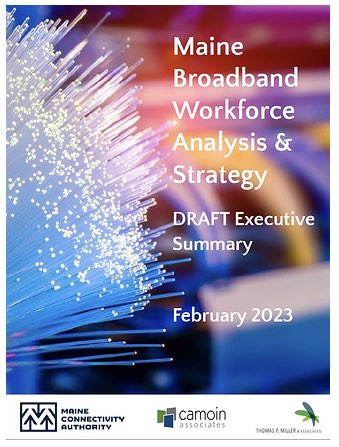
You can (should!) download and read the Maine Broadband Workforce Strategy Report.
Have You Thought About Improving Your Productivity?
With the fiber optic industry facing a major shortage of competent fiber
techs already and the US offering billions of dollars to build
broadband networks, there is a lot of talk about workforce development.
That's obviously necessary, but it's not as easy as it sounds. First of
all it's hard to find people interested in becoming fiber techs when
unemployment is so low and everybody else is trying to hire them at the
same time. Then if you do get them interested, it takes time to train
them and have them learn by OJT to become proficient at their job.
Perhaps it's time to consider another parallel solution - increasing
productivity. Getting more work done with current techs is not going to
completely solve the long-term problem of a tech shortage, but it is an
important part of the long term solution. It's something FOA has been
thinking about as we have all these discussions with workforce
development groups.
Increasing productivity requires considering the entire process of a
fiber optic project, starting at the design phase. Things have changed a
lot in the 40 plus years history of fiber optics, but many networks
today don't look much different than they did way back then and many
techs are still working the same old way. Perhaps even more important is
that decisions are being made by people who are not familiar with
modern fiber optics components and installation techniques that are more
efficient, cost effective and prolong the life of the network.
The options for fiber optic cable plant construction have changed. It's
not just dig a trench, drop in some conduit and pull cable or lash new
fiber to current fiber or legacy copper cables. If the construction is
underground, careful consideration of the route of the cable plant might
help you find unused ducts for use with new cables. New products allow
removing some old ducts and replacing them with fabric ducts or
microducts that can carry new cables in the conduit without
construction.
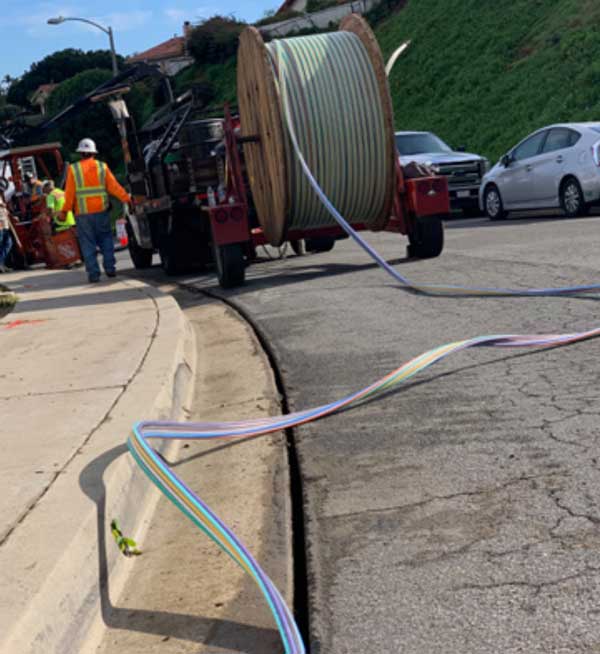
This small trench is designed to allow installation of six 288 fiber microcables in Solana Beach, CA.
A combination of microtrenching and directional boring can speed up
underground construction compared to trenching and reduce the disruption
along the construction route. If the contractor is not familiar with
these techniques, renting equipment with experienced operators or
subcontracting the work is often preferable to learning on the job
themselves, especially on the first few jobs.
Another issue for underground construction is location of other
underground services. Nothing slows down the job and adds to the cost
more than damaging something already there. It happens way too much; two
contractors broke gas lines within a mile of the FOA office last year.
Thankfully, quick thinking by the local fiber department kept them from
becoming tragedies. Be sure to "call before you dig" and/or "click
before you dig" to find out what's on you route and have a tech with
underground locating equipment monitoring your path before you dig or
bore.
The owner of the cable plant route should require the contractor to
follow the federal "Dig Once" policy. If you are installing cable
underground, no matter whether you trench, microtrench or bore, you
should install extra ducts for future networks. Microducts are tiny, a
bundle of 6 is about the same size as a traditional fiber duct, fits
easily in a single microtrench or bore and can provide for lots of
future expansion.

Lashing an aerial cable
There is still plenty of aerial cable in use and contractors are
installing new fiber optic cables, many for 5G. There is now the "one
step make ready" process where the installing contractor is allowed to
move cables already installed and overlash to current cables on a
messenger, which can make adding cables much faster and cheaper. If you
are going to do this, make sure the installing techs know what they are
doing because mistakes here can damage other carrier's cables and be
really expensive to fix.
In the design of the cable plant, new component developments can help
productivity too. Microcables contain more fibers in smaller cables,
making them easier to install. The bigger versions of microcables, high
fiber count cables, can also save time and money; cables of 864 fibers
are now as small as 144 fiber loose tube cables of the past. The 864
fiber cables can work for both underground or aerial installation. Be
careful, as bigger cables are mainly intended for short urban use
underground and require very large vaults for storing service loops
because of the large bend radius required.
(We're hearing rumors that these cables are getting fibers broken
during installation with the possible cause(s) being exceeding bend
radius or pulling tension, using improper installation equipment or
maybe even the cable designs. We're investigating this and will report
back in the near future. But please ensure installers follow manufacturer's recommendations carefully.)

Fusion splicing a splice-on connector (SOC)
Termination has been changing in ways that enhance productivity also,
with fusion splice on connectors replacing the more common practice of
splicing pigtails. Many of the SOCs come pre-cleaved,
ready to splice, saving half the cleaving time, and they do not require
separate splice protectors or closures. Most single fiber splicers now
have a SOC option.
High fiber count cables present another opportunity for productivity,
splicing with mass or ribbon fusion splicing. The time required for
splicing these cables is substantial and ribbon splicing is essential.
Most of these cables are ribbon cables anyway, so investing in a ribbon
splicing machine will be required. Ribbon splicing saves a lot of time;
splicing 12 fibers at once only takes about twice as long as splicing a
single fiber, so it's about 6 times faster. Even regular loose tube
cables can benefit from ribbon splicing, as splicer manufacturers offer
fixtures to splice all 12 fibers in a regular buffer tube at once.
Testing lots of fibers is another challenge because it can take large
amounts of time and requires more skilled technicians. There are no
"mass" fiber testers like ribbon splicers, but test equipment companies
have used advanced software techniques to speed up testing without
compromising the quality of the test. These advanced testers do multiple
tests like insertion loss and OTDR testing in seconds and store the
data for reports needed for cable plant documentation. That can be a
major time saver.
Do Not Forget Training
Newer equipment is generally much more automated, faster and easier to
use, adding to productivity. But besides investing in some new
equipment, there is a big payback for investing in tech training for the
components and equipment you switch to. When you want to use a new
component or buy that new equipment, the manufacturer will usually
provide training for your techs. Take advantage of it.
Special Safety Notice

In the construction industry, “safety stand-downs” are used to describe
activities where normal work is paused and the entire site focuses on a
specific safety issue. Some employers may use stand-downs to call
attention to specific hazards present on their site as an intervention.
The National Stand-Down to Prevent Struck-by Incidents is a voluntary
event for employers to talk directly to employees about safety. Any
workplace can hold a stand-down by taking a break to focus on "Struck-by
Hazards" and reinforcing the importance of training and prevention. The
event is held in conjunction with National Work Zone Awareness Week.
Struck-by hazards are present on nearly every job site, and include
things like falling and flying objects, vehicles and heavy equipment,
and swing hazards from cranes. These incidents are the number one cause
of nonfatal injuries in construction and the leading cause of death
among heavy and civil construction workers, but they can be avoided by
careful planning, training, and the use of controls.
Contractors, workers, and safety professionals across the nation are
invited to join this event. Workers can be educated on hazard prevention
including topics such as avoiding blind-spots around large equipment,
proper use of high-visibility clothing, creation of lift plans, use of
tool tethers and safety nets, and use of safer pneumatic nail guns and
other air-powered tools.
Read more.
FOA Welcomes 4 New Approved Training Organizations
FOA is pleased to welcome 4 new schools to the
worldwide network of training organizations offering FOA approved
training and FOA certifications. With FOA's extensive worldwide network
of training organizations, it's possible to get FOA-certified almost
anywhere! Use the updated FOA schools map below to find any FOA school.
402 Bossier Parish Community College Bossier City LA
407 Virginia Highlands Community College, Abingdon VA
408 British Columbia Institute of Technology, Burnaby, British Columbia, Canada
776 Prime Training and Services, Akwa, Cameroon
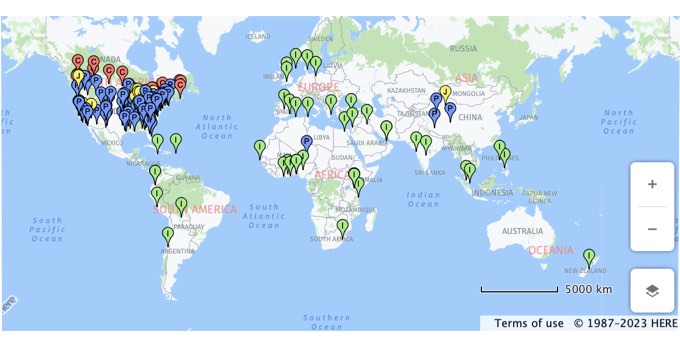
FOA has updated its online interactive map showing the FOA approved
schools around the world. The new map shows the location of FOA schools,
allows zooming in on a location and now includes a search function that
allows locating a school by name or location. Once you locate a school,
you can click on the school name and link to their website.
Latest FOA Book: Fiber Broadband (Paperback and Kindle)
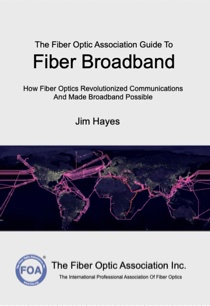 How does broadband work? Without fiber optics it would not work.
This book is not the typical FOA technical textbook - it is written for
anyone who wants to understand fiber broadband or fiber optics or the
Internet. It's also aimed at STEM teachers who want to include
communications technology in their classes. This book will try to
explain not only how fiber broadband works, but how
it was developed. It is intended to be an introduction to
communications technology
appropriate for a communications course at almost any level (junior
high, high school or
college,) for managers involved with broadband projects, or for anyone
who just wonders how all this stuff works. How does broadband work? Without fiber optics it would not work.
This book is not the typical FOA technical textbook - it is written for
anyone who wants to understand fiber broadband or fiber optics or the
Internet. It's also aimed at STEM teachers who want to include
communications technology in their classes. This book will try to
explain not only how fiber broadband works, but how
it was developed. It is intended to be an introduction to
communications technology
appropriate for a communications course at almost any level (junior
high, high school or
college,) for managers involved with broadband projects, or for anyone
who just wonders how all this stuff works.
The Fiber Optic Association Guide To Fiber Broadband Paperback ($12.95) and Kindle ($9.95) versions available from Amazon or most booksellers. Kindle version is in color!
New Fiber U MiniCourse - Fiber Optic Project Management
.jpg) Managing
a fiber optic project can be the easiest part of the installation if
the design and planning have been done thoroughly and properly, or, if
not, it can be the the hardest. It's certainly important to understand
what managing a project entails.
This new Fiber U MiniCourse starts by defining a fiber optic project
then explains what's involved in managing it from concept to operation. Managing
a fiber optic project can be the easiest part of the installation if
the design and planning have been done thoroughly and properly, or, if
not, it can be the the hardest. It's certainly important to understand
what managing a project entails.
This new Fiber U MiniCourse starts by defining a fiber optic project
then explains what's involved in managing it from concept to operation.
As usual with Fiber U online learning courses, the course is free and like the Fiber U FTTH course, the Fiber U Certificate of Completion is free also.
With so many new fiber optic projects starting up and so
many new managers, FOA decided this MiniCourse should also offer the
Fiber U Certificate of Completion free.
New Fiber U MiniCourse Fiber Optic Project Management
More Translations of FOA Textbooks
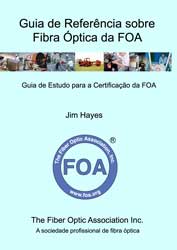 FOA is a very international organization and it works hard to
accommodate the language needs of everyone. We have been translating our
books and website into the languages most requested, and this month, we
add two more textbook translations. We also want to thank Jerry Morla,
FOA CFOS/I instructor and Director who has been doing the recent
translations into Spanish, his native language. FOA is a very international organization and it works hard to
accommodate the language needs of everyone. We have been translating our
books and website into the languages most requested, and this month, we
add two more textbook translations. We also want to thank Jerry Morla,
FOA CFOS/I instructor and Director who has been doing the recent
translations into Spanish, his native language.
Details below.
Cross Reference Guide to Textbooks, Online Guide and Fiber U FOA Videos Guide.
FOA has a web page with resources on fiber broadband and the IIJA/BEAD funding programs.
FOA Newsletter
Sections
News
Technical
Worth
Reading Q&A
Training/FiberU
Resoures
Safety About
|
|
News
Lots more news
in Worth Reading below
|
IMSA and FOA Hold First CFOS/D Design Class
FOA Instructor Tom Collins conducted the first IMSA/FOA Fiber
Optic Network Design certification course recently, using a hybrid
online and in-person format. IMSA, the professional society of traffic
engineers, has adopted the FOA CFOS/D design certification for their
membership, accompanying the FOA CFOT certification they have been
offering since 2017. This first course was also a train-the-trainer for
IMSA instructors who will begin offering the course in their home
regions.

Participants making class presentations on their case study projects
For over one year the FOA and IMSA have been planning how to roll out
the hybrid Design certification class. The pilot program consisted of
two Zoom classes followed by a one day in-person class. The ZOOM classes
comprised of PowerPoint / lecture, online assignments and quizzes from
the textbook, discussions on course materials and what to prepare for
their individual project presentation. The project presentations were an
integral part of the class. Each participant had to prepare a
presentation on the design of a fiber optic network, following the case
studies format used in the course but based on their local work.

Details from class projects
The one day in- person class was held at About Phase Academy in Port
Orange, Florida. Instructor Tom Collins provided a review of the book
and then had each person presented their fiber project presentation to
the class. Every presentation was outstanding especially the PowerPoint
materials developed by the presenters. There was an array of topics. ALL
participants passed their FOA certification test with flying colors.
IMSA is planning to roll out future classes as soon as possible.
"Working with the Fiber Optic Association, Inc., we have built this new
certification to go beyond the initial Certified Fiber Optic Technician,
which covers the basic installation of ITS, Traffic, Fire Alarm and
Communications systems. The new fiber optics design class will improve
skill sets and certify that recipients are now qualified to design fiber
optic systems." "Certified Fiber Optic Specialist/Design delivers on
our promise to offer tests that reflect the kinds of advanced technology
our members encounter every day,” said IMSA Board of Directors
President Kevin Musick.
Bob Metcalfe, Co-inventor Of Ethernet, Wins Turing Award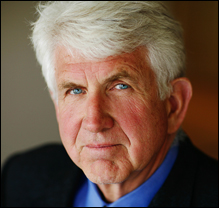
Fifty years ago at Xerox Palo Alto Research Center (PARC), two young
engineers were tasked to develop a way that the personal computers Xerox
was developing could communicate with each other inside the labs. Bob
Metcalfe was the idea person and David Boggs was the engineer who could
implement the hardware. The original Ethernet operated at about 3 Mb/s
over coax cable, but Metcalfe saw the media as "the ether" which could
be any method that could transmit signals, including copper wires, radio
or even the new technology of optical fiber.
Metcalfe worked with Xerox and Digital Equipment Corp. (DEC, the
inventor of the minicomputer) and founded one of the first comuter
networking companies, 3com, in 1979. He was instrumental in the IEEE
creation of the Ethernet standard (IEEE 802.3) we still use today.
Metcalfe is still active today as an Emeritus Professor of Electrical
and Computer Engineering (ECE) at The University of Texas at Austin and a
Research Affiliate in Computational Engineering at the Massachusetts
Institute of Technology (MIT) Computer Science & Artificial
Intelligence Laboratory (CSAIL).
ACM, the Association for Computing Machinery, named Bob Metcalfe as
recipient of the 2022 ACM A.M. Turing Award for the invention,
standardization, and commercialization of Ethernet. The ACM A.M. Turing
Award, often referred to as the “Nobel Prize in Computing,” carries a $1
million prize, with financial support provided by Google, Inc. The
Award is named for Alan M. Turing, the British mathematician who
articulated the mathematical foundations of computing. (Read the ACM announcement here.)
We first met Bob at COMNET, the communications conference in
Washington DC in the mid-1990s when we were together on a panel
discussing the future of the new public "Internet." Bob represented the
networking technology and we (JH) were representing fiber optics. When
asked about Internet standards, Bob's answer became one of our favorite
quotes: "The wonderful thing about standards is we have so many to
choose from."
Congratulations, Bob!
JH
TIA BEAD Success Summit
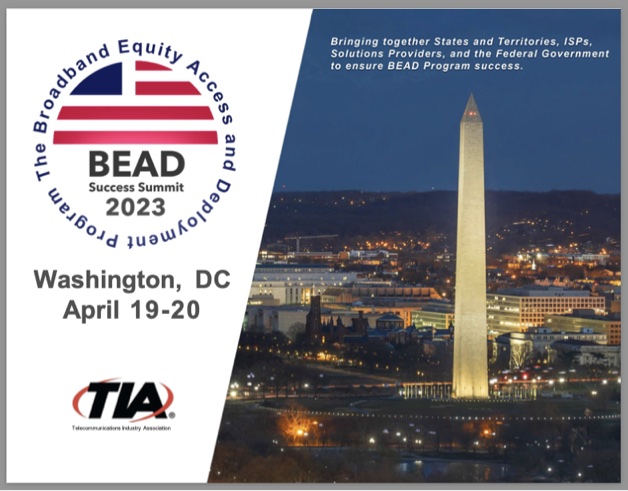
The US government's Broadband Equity Access and Deployment (BEAD) program has created plenty of speculation about
what it means and how it will be implemented, not to mention a lot of
hard selling of products and services that might be involved. If you are
tired of the speculation and sales pitches, this might be the
conference for you.
TIA, of course, is best known for it's work in standards, but its
location in Washington, D.C. and connections into the various federal
agencies and Congress gives it unique insight into the progress of the
IIJA/BEAD programs. And a lot of what has been said over the last year
is speculation as the actual programs take shape, so now is a much
better time to get a more down-to-earth viewpoint on the programs from insiders in the know.
In addition TIA has a unique focus on supply chain issues, cyber
security and privacy, important areas of concern in broadband networks
that should be of interest to those planning or operating broadband
networks.
The timing of this conference could be good for getting updated on the BEAD program, since all states have
received their initial BEAD planning funds but the next steps depend on
the FCC broadband availability maps. They were released late last year,
but we hear that number of comments on the maps is in the hundreds of
thousands.
FOA is a TIA Member, so TIA will offer member discounted pricing
to FOA certified techs, schools and corporate members. Use the FOA
discount code "2023FOA" when registering.
Information and registration on the TIA BEAD Success Summit.
More information on TIA efforts to support the NTIA BEAD program.
Registration Open For ISE Expo 2023

ISE EXPO 2023, the OSP telecom conference, showcases the next wave of
disruptive products, technologies and solutions for todays' and future
networks. It's a conference for the professional who plans, builds,
operates and maintains these networks. At ISE EXPO 2023 you can see,
touch and demo new products, technologies and solutions for telecom
networks.
Join ISE EXPO 2023 in Kansas City, Missouri, and experience why network
professionals from around the globe attend our engaging seminars,
commanding keynote presentations, solutions-based vendors and
face-to-face networking.
More about ISE Expo 2023 (and early bird discounts)
Wireless Infrastructure Statistics
The Wireless Infrastructure Association (WIA) has released their 2022 Wireless Infrastructure By The Numbers report about their $46 billion industry.
The following key statistics show the strength of the U.S. wireless infrastructure industry at the end of 2022:
• 142,100 cellular towers were in operation;
• 209,500 macrocell sites, not including small cells, were deployed;
• 678,700 macrocell sectors, not including small cells, were in operation;
• 452,200 outdoor small cell nodes were deployed;
• And 747,400 indoor small cell nodes were in use, including private
CBRS networks, DAS, small cells and mmWave and other licensed frequency
bands.
Deploying and operating this infrastructure translates into jobs:
401,100 people or full-time equivalents were employed in the U.S. to
build, maintain and operate the nation’s wireless and mobile networks
That's a lot of antennas connected by a lot of fiber!
Download a copy of the 2022 Wireless Infrastructure By The Numbers report.
Telegeography 2023 Submarine Cable Map

Telegeography just released the 2023 Submarine Cable Map, which depicts 529 cable systems and 1,444 landings that are currently active or under construction.
This new edition highlights in the Americas:
North America is seeing increasing diversity in submarine cable landing locations. New cables are coming into places like Virginia Beach and Myrtle Beach on the U.S. East Coast. Out west, the first trans-Pacific cable landings are planned for Canada and Mexico.
Outside of the recently-activated EllaLink cable, South America's submarine cable connectivity remains heavily-focused on the United States. This will continue with the planned activation of cables such as Firmina, Carnival Submarine Network-1, and AMX-3/Tikal.
You can explore this new map in detail here. Physical copies are also available in their map store.
Telegeography also introduced the 2023 State of the Network Report—their sixth annual review of all things telecom. This
information pieces together what we’ll be talking about in the year
ahead, each data point another patch in the quilt that is 2023.
Looking for a good online fiber optic course? The FiberWizards Essentials - CFOT Prep Course could be a solution
How do you get new hires up to speed quickly? Continue training current
employees and prepare them for the certification your customers are
requiring? OJT - On-The-Job-Training. - is the usual answer, but an OJT
program like the FOA's OJT-To-Cert program - requires a commitment from experienced techs and supervisors to ensure the techs stay on course.
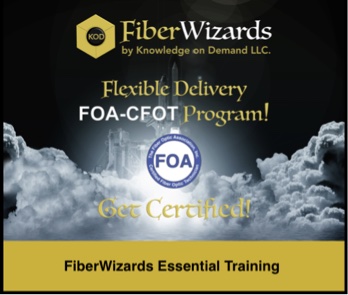
FOA Master Instructor and Director Jerry Morla has a solution that can
work for most companies, the "FiberWizards Essentials - CFOT Prep
Course." Students will get lots of flexibility to learn on their
own terms with a very tailored and personalized experience including
one-on-one coaching, virtual presentations, online modules, and access
to a private Slack channel for support.
Students will get a lab kit when they join, to explore behaviors of
light in fiber on their own. If the students need equipment to complete
the hands-on part of the course, FiberWizards offers rentals of
equipment and consumables kits for students within the Continental US.
For companies who need to train their fiber techs but lack the time
commitment needed from their top techs, which is practically all of
them, the FiberWizards course could be a very good - and cost effective -
solution.
FiberWizards Essentials - CFOT Prep Course
|
Technical
Fiber optic
technology, standards, equipment, installation,
etc.
The FOA
Update Page covers the new technology
and applications we covered in this newsletter
recently. Now you can review all that new tech at
once.

Cross Reference To FOA Technical Reference Materials
The FOA has almost 1,000 pages of technical information on the FOA Guide,
100+ videos and two dozen online courses at Fiber U, all this can make
it difficult to find the right information.
Cross Reference To FOA Tech Materials
To help this, we have created a cross reference guide to the textbooks,
Online Guide and Fiber U courses, all the FOA technical information.
Besides the textbooks, online Guide and Fiber U, each section of the
Guide also includes links to the 100+ FOA videos available.
Cross Reference Guide to Textbooks, Online Guide and Fiber U
FOA Videos
We have also rearranged the 100+ FOA videos in similar categories on the
Contents Page of the Online Guide, making the videos, especially the
lectures, much it much easier to find a video on a particular
topic.
FOA Videos Guide.

Want to know more about fiber optics? Study
for FOA certifications? Free
Self-Study Programs are on Fiber
U®
|
 OptConn
is a value-add re-seller of optical connectivity products, services and
solutions. With over 30 years of experience in the fiber optics
industry we are here to serve your requirements from fiber optic
training with FOA certification to products, materials and supplies. OptConn
is a value-add re-seller of optical connectivity products, services and
solutions. With over 30 years of experience in the fiber optics
industry we are here to serve your requirements from fiber optic
training with FOA certification to products, materials and supplies.
We have partnerships with industry leading
manufacturers to support your installation, splicing and testing needs.
Our goal is to guide, support and recognized our client’s requirements.
Learn more about OptConn
|
Problems With Microcables and High Fiber Count Cables?
We're hearing rumors that these cables are getting fibers broken
during installation with the possible cause(s) being exceeding bend
radius or pulling tension, using improper installation equipment or
maybe even the cable designs. We're investigating this and will report
back in the near future. But please ensure installers follow manufacturer's recommendations carefully.
In 2018 Linden Fiber Optic Cables Began A Long Journey To Jupiter
Tasked with designing and building a fiber optic
cable that would survive the rigors of deep space, Linden Photonics
worked with the Airbus Defense & Space, the Space Research Institute
(IWF) at the Austrian Academy of Sciences, Fraunhofer, among others, to
design and build optical cables for the mission to the icy moons of
Jupiter (JUICE), scheduled to launch in April, 2023. Linden’s unique
design allowed sufficient strain relief necessary for polyimide fibers
to pass rigorous temperature cycling tests from -1900 to +1200 C.
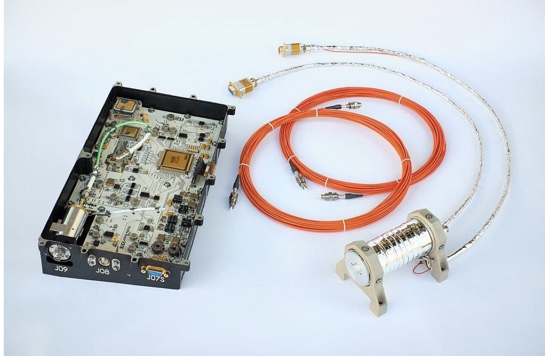
Flight unit of the JUICE J-MAG scalar magnetometer: Electronics with
laser unit (left), optical fiber assemblies (middle) and sensor (right)
The J-MAG instrument onboard ESA’s JUICE mission to the icy moons of
Jupiter is going to perform magnetic field measurements with the help of
two vector (fluxgate) sensors and an additional optical scalar sensor
(MAGSCA), which provides a reference for in-flight-calibration of the
fluxgate sensors. Due to the JUICE mission’s challenging environmental
conditions in terms of particle radiation and temperature range as well
as the need for a fully non- magnetic design, a set of customized
fiber-optical cable assemblies had to be designed and qualified.
This Linden design can be used to achieve similar temperature
performance for cables incorporating other custom fibers such as
polarization maintaining, reduced diameter, silicone coated, rare earth
doped, and metallized optical fibers.
More on the JUICE mission.
More on the development of the fiber optics for the magnetometer.
Watch the launch
Date: 13 April 2023
Location: Europe's Spaceport in French Guiana
Vehicle: Ariane 5
Destination: Jupiter system
Great Idea For Fishtape - It Glows

Klein Tools (www.kleintools.com), has introduced a new 20' or 40’
Glow in the Dark Fish Tape for applications in low light jobsites. It's
an optimal fish tape for installing wire or cable behind walls and
ceilings, in short box-to-box runs and branch circuits or in flexible
tubing
Klein 20' or 40’ Glow in the Dark Fish Tape (Cat. No. 50660)
Managing Fiber Optic Projects - The Gantt Chart
(With An Excel File To Make Your Own)
The most common way to track projects is the Gantt Chart, a
chart of activities that tracks the progress of projects along a
timeline. each activity is represented by a bar and the position and
length of the bar represents the starting date and duration of the
activity. This allows you to see what activities are needed for the
project, when the activities start and end so it can be used to track
the progress of the project visually. Here is what a Gantt Chart for a
fiber project might look like:

You might remember an article in the FOA Newsletter in April 2022 or the FOA Guide page on Project Management about the timing of a fiber optic project where we showed the progression of steps in a project like this:
The Gantt Chart above is simply this list converted to a Gantt Chart
using a Microsoft Excel spreadsheet. You can download a copy of the FOA Gantt Chart spreadsheet (xlsx file - 16kB)
and use it to create your own Gantt Chart for any project. All you have
to do is to input your own data and change the activity names as
necessary. You can also follow the directions from Microsoft to create your own version.
More Help On Color Codes (Now Copper Cabling And Fiber Optics)
The FOA has created a pocket guide to fiber
optic color codes that we are sending to new and renewed CFOTs. It has
color codes for fibers and buffer tubes, connectors and premises cables
inside and on the back, QR codes to take you directly to the FOA Guide
and Fiber U.

The FOA
Guide page on Fiber Optic Color Codes is one of the most read pages on the FOA
website and the Fiber Optic Color Codes minicourse on Fiber U very popular also.
Here's a do-it-yourself FOA Guide To Fiber Optic Color Codes card.
Just download the PDF file, print it on a color printer and fold it up
as shown. Then you have your own pocket guide to color codes. Make a
bunch for your co-workers too.
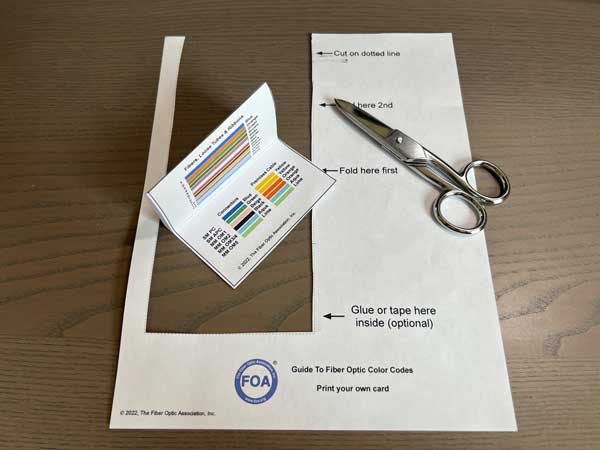 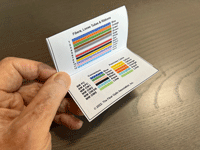 
Then we realized that many of your also do structured cabling
work, so it was a natural to add a Color Code Guide for UTP copper
cabling in printable (below) and electronic (above) versions.

But we did not stop there. We know how many of you use your mobile devices on the job, so we created a version of the Color Code Guide you could download
and use on your smartphone or tablet. It's a PDF file, so you just
download it and save it on your device and it will be with you always.
Here are the links to download your own FOA Guides to Fiber Optic Color Codes
FOA Guide to Fiber Optic Color Codes (print your own version) PDF
FOA Guide to Fiber Optic Color Codes (electronic version for your smartphone, tablet or PC) PDF
And For UTP Cabling
FOA Guide to UTP Cabling Color Codes (print your own version) PDF
FOA Guide to UTP Copper Cabling Color Codes (electronic version) PDFWarning For Techs Doing OSP Restoration

FOA received an inquiry about whether techs
working on restoring OSP links should be concerned about eye safety if
the link used fiber amplifiers. To answer this question, we had to do some research on fiber amplifiers.
The short answer is YES, you should be concerned. The long answer is
more technical and includes details that every OSP tech needs to know.
See "Fiber Amps And Restoration" in the FOA Newsletter Archives..
Try The FOA's Online
Loss Budget Calculator
FOA
has written many articles about loss budgets,
something everyone involved in fiber optics needs to
know and needs to know how to calculate. We've
created a online Loss Budget Calculator that does
the work for you. Just input your cable plant data
and it calculates the loss budget. It works on any
device, especially smartphones and tablets for field
use and even allows printing the results.

Bookmark
this page (especially on your smartphone): FOA Loss Budget Calculator
Online
|
Worth Reading
Each month we read
hundreds of newsletters and online articles. These
are the ones we think you will find "worth
reading."
FOA has a web page with resources on fiber broadband networks and the IIJA/BEAD funding programs.
Cross Reference Guide to FOA Textbooks, Online Guide and Fiber U
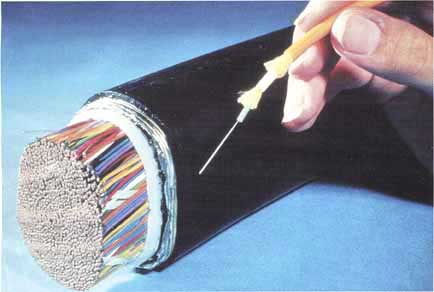 AT&T PR photo from the mid 1970s AT&T PR photo from the mid 1970s
The FOA's History
|
Worth Reading (And
Watching):
April 2023
Telegeography Submarine Cable Map 2023 - You can also buy copies - Telegeography

Taiwan suspects Chinese ships cut islands’ internet cables - Los Angeles Times
Broadband Communities Summit Conference, Houston, May 1-4, 2023
March 2023
CABL® (cabl.com) serves
the business needs of the Broadband industry (including traditional
cable TV, fiber, telecom and satellite providers) with employment
listings, classified ads, discussion forums, and more. A contractor told us it's where they find lots of opportunities for subcontracting.
The State of the Network in 2023 (eBook) Telegeography

From Telegeography' The State of the Network in 2023
The Secret to Future Proofing, by Jim Hayes, FOA President, ISE Magazine
Open Access Conduit in West Des Moines, Iowa Brings Google Fiber, Choice to City Residents (Dig once - buy conduit!) ILSR Community Networks
Emergency Repair of Subsea Fiber Optic Cable in Anguilla (LinkedIn)
February 2023
Friday the 13th Mapping Challenge Deadline Highlights Failed Process -
The new national broadband map challenge process - crucial for future
infrastructure funding - looks to have been hamstrung by critical
lacking information from the start, and that has us worried.
Ask The Experts: What Defined The Industry in 2022? Telegeography
Review Telegeography's Presentation On the 2022 Fiber Optic Market
January 2023
The 45 Year Old Overnight Sensation - article by FOA President Jim Hayes in ISE Magazine (Read the complete Nov/Dec issue of ISE Magazine here.

Going
the distance: What you need to know about breaking the 100-meter
distance limitation Cheating on the standards for UTP cable - CI&M Magazine
FCC Requires Broadband Providers to Display Broadband Nutrition Labels not
nutrition labels on the product's "high fiber content" but key
information consumers want−prices, speeds, fees, data allowances, and
other critical information.- Broadband Communities
Fiber
optics take the pulse of the planet It’s like radar, but with light.
Distributed acoustic sensing — DAS — picks up tremors from volcanoes,
quaking ice and deep-sea faults, as well as traffic rumbles and whale
calls. Knowable Magazine.
From Earlier Issues
ESRI has created an ebook on GIS location technology for telecom. Use the link to download the book.
The First Transcontinental Telephone Line
began operation on July 29th in 1915 - 3400 miles between New
York and San Francisco - required over 100,000 telephone poles! Wonders
of World Engineering
Conocimiento Esencial: ¿Por qué la fibra óptica? creado por FiberWizards
Recruiting And Training Today's Fiber Optic Workforce - Learn the fundamentals to recruit and train new fiber optics - by FOA's Jim Hayes in ISE Magazine.
Explosive Fiber Broadband Expansion Drives Need for Fiber Technician Training Programs
- Telecompetitor - As fiber sees record-setting deployment levels, the
demand for fiber optic technicians is stronger than ever.
Google Video On Their Undersea Cables YouTube Slick but interesting video on how undersea cables are designed, built and used.
Construction Without Disruption - FOA President Jim Hayes' column in ISE Magazine
Fiber Optics Installed By The Lowest Bidder - ISE Magazine - by Jim Hayes, FOA President.
Building Broadband During Component and Worker Shortages
- Broadband Communities - Completing broadband builds requires
competent fiber optic techs, but training them requires understanding
how they learn - by Jim Hayes, FOA President.
Worth Reading - Magazines, Websites and Newsletters

The
latest Issue of
dP-PRO, the "call before you dig" magazine, is
online.
dpPro sponsors the annual digging safety conference each year - next year in Tampa.

New Fiber Optic
Magazine In Spanish
Todo Fibra Optica is
a new digital magazine in Spanish for fiber optics
in Latin America and South America. Jose Enriquez, editor of Todo
Fibra Optic magazine has many years
experience in the fiber optic industry so he knows
the industry well. FOA will be working with him to
share our extensive technical materials in Spanish.
Read their newsletter here. It is now available online in English and Spanish.
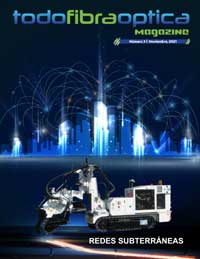
All issues and subscriptions.
Contact:
José Manuel Enriquez Mora, Editor
Todo Fibra Optica LLC
https://todofibraoptica.com/revista-ediciones/
+52 222 302 8224
jose.enriquez@todofibraoptica.com
RTI Telecom Magazine from Brazil, in Portuguese. A revista RTI do mês de abril já está disponível online e recomendo a leitura de alguns artigos:
1995-2020
- FOA's 25th Anniversary!
As
part of celebrating 25 years of serving the fiber
optic industry as its primary source of technical
information and independent certifying body, FOA
thought it appropriate to create a short history of
the organization and how it has developed to
help the fiber optic industry. We also wanted to
recognize the contributions many people have made to
the organization over the years that made FOA what
it is today.
The FOA history is now archived on the FOA
website where you can read it anytime or link to
it. Updated
info - dB, total internal reflection and science
projects,
Worth Reading - News
Summary - Past Links Worth Repeating
1983
Video of AT&T's First Test Of A Submarine
Cable System From the AT&T Tech
Channel archives (worth exploring!)
Richard
Epworth's Optical Fiber History from his work
at STL from 1966 with Charles Kao.
Communications Systems Grounding
Rules: Article 800 provides specific
requirements by
Michael
Johnston, NECA Executive Director of
Standards and Safety in EC Magazine
US Broadband Coverage By Service
Provider from the FCC
How
To Build Rural Broadband, Learning From History
In the August 2021
FOA Newsletter, we published a lengthy article on
rural broadband and compared it to rural
electrification in America in the last century.
Much of the comparison was based on an article
written in 1940 by a USDA economist, Robert Beall,
called "Rural Electrification."
If
you are interested in or involved in rural
broadband, we recommend you read the article "How
To Build Rural Broadband, Learning From History"
in the August 2021 FOA Newsletter and
read the Beall article also.
Recycling Fiber Optic
Cable - Contact:
Steve Maginnis
LD4Recycle/ CommuniCom Recycling
(Visit
website)
sm@LD4Recycle.com
803.371.5436
Sumitomo's Ribbon
Splicing Guide - download from
one of the leaders in splicing.
"Who Lost Lucent?: The
Decline of America's Telecom Equipment Industry"
This is a MUST READ for managers in telecom or any
industry!
This long and
well-researched and annotated article in American
Affairs Journal should be mandatory reading
for every high level manager in a telecom company -
or any other company for that matter. To summarize
the article, today, America has no major telecom
equipment company and fears the major suppliers of
equipment who are all foreign, especially the Huawei
from China. This article explains how America got
into this deplorable state.
OFS also has an excellent
website and blog of tech articles worth browsing.
IEC 60050 - International
Electrotechnical Vocabulary - An
extensive dictionary for fiber optics in English and
French. Highly technical - this is one definition:
"mode - one solution of Maxwell's equations,
representing an electromagnetic field in a certain
space domain and belonging to a family of
independent solutions defined by specified boundary
conditions"
If you are interested in restoration -
aren't we all? - you should also read this
article in dpPro magazine by FOA President Jim
Hayes: Damage Protection Requies
Looking Overheas As Well As Underground
- dpPRO Magazine - about the problems with
aerial cables. His previous article for the
magazine was New Techniques for Fiber
Optic Installation.
How much fiber optic cable is
manufactured each year? CRU Reports -
unsurprisingly China is by far the largest market
today
The Institute for Local
Self-Reliance weekly newsletter has
lots of interesting articles and links.
Universal access to broadband
is a cornerstone to a strong economy,
Achieving universal access will require
community partnerships. by Alfreda
B. Norman, Sr. VP, Federal Reserve Bank of
Dallas
FIBER TO THE FARM: The
co-ops that electrified Depression-era farms are
now building rural internet. Be sure to check out
the high-tech equine installation equipment.
Next Century Cities Newsletter
- News from cities around the US
including Detroit and New York plus small
Infrastructure Get Some
Respect, NY TImes "On Tech"
"The magic of the internet requires a lot of
very boring stuff behind the scenes. "
DIRT
Report On Damage To Utilities Common Ground
Alliance (CGA) annual DIRT report provides a
summary and analysis of the events submitted into
CGA’s Damage Information Reporting Tool (DIRT) for
the year 2018. The complete report is available
for download here. In addition,
there is an interactive dashboard that
allows users to filter the data more by
factors contributing to damages.
Structured Cabling News
- a website and weekly newsletter about cabling.
Fiber Trivia From
Corning.
The
Future Of Work Is Skills - So Stop Worrying
About Degrees - The
reality is the future of work is about skills, not
just degrees. (FOA Newsletter Feb 2020)
The job market is hot. So why
are half of U.S. grads missing out?
VIAVI Books On
Fiber Optic Testing (2 volumes) - They're back!
 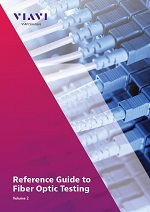
Besides
the FOA reference materials, two JDSU/VIAVI
textbooks, Reference Guide to Fiber Optic Testing,
Volumes 1 and 2, were used as references for
some of the FOA courses and are recommended for
instructors and students. The books are available
from VIAVI as eBooks and the everyone should
download them and recommend them to others.Download
yours now. Volume 1. Volume 2. Viavi Books
Ciena's Submarine Cable
Handbooks (4 to download)
Guidebook To MPO
Testing OptoTest
offers this complete guide to MTP®/MPO testing. In
this guide, you will learn all there is to know
about the different test methods, equipment
options, troubleshooting, and best maintenance
practices to ensure that you have the best testing
experience. Go here to download the book.
50th Anniversary of The
Development of Low Loss Fibers A history
of the development of low loss fiber, a fascinating
story by Jeff Hecht on the OSA (Optical Society of
America) website.
How OFS Makes Fiber
Interesting YouTube video on how fiber is made.
Perhaps a little too much "show biz" but
fascinating. If you have ever seen fiber
manufacture, look at this video. You will be amazed
at how big preforms have become!
The True Cost of Telco Damages
(what backhoe fade or target practice can
cost)
Rural Electric Cooperatives:
Pole Attachment Policies and Issues, June 2019.
Clearfield-FOA Certification
Training Clearfield is now offering
their customers an FOA
CERTIFICATION course. This course
provides a basic understanding of fiber optic
technology, as well as Clearfield product
knowledge and how Clearfield’s integrated product
systems work together in a fiber network.
Substandard Contractors - Fiber
Optic Knowledge Doesn't Always Trickle
Down (EC Mag)
|
Q&A
When readers ask us questions, we genrally refer them to FOA
resources where they can find the answer to their question and many
more. We first send them to the FOA Guide
which is the table of contents for the FOA technical resources. There
they can find pages indexed by topic and a search engine for the FOA
website. It also links them to FOA videos and courses on our free online learning site Fiber U.
The FOA
Fiber FAQs Page (FAQs = frequently asked
questions) gathers up questions readers have
asked us (which first ran in this newsletter)
and adds tech topics of general interest.
|
Good Question!
Tech
Questions/Comments From FOA Newsletter Readers
April 2023
Electromagnetic Interference
Q: Is there and electromagnetic interference with optic cables?
A: The fiber is glass and the cable is plastic, neither of
which are affected by electromagnetic interference. There is a cable
used in electrical transmission lines called OPGW- optical power ground
wire - that has fiber inside a wire conducting high voltage - doesn’t
bother the fiber at all.
Bandwidth Issues
Q: We are having transmission problems on long fiber runs with mixes of fiber types. Ideas?
A: Perhaps the problem is simply the total bandwidth of the fiber. If
the long spans are G.652, it will probably have CD and perhaps PMD
issues. It’s worth doing fiber characterization tests on it. See this
page in the FOA Guide: https://foa.org/tech/ref/testing/test/CD_PMD.html If you are over 100G, coherent transmission might overcome the problems with bandwidth.
Can we get the following information from OTDR tests?
1. Attenuation
Yes, see https://foa.org/tech/ref/testing/OTDR/OTDR.html
2. Chromatic dispersion (Need some help )
On some special OTDRs with mulitple wavelengths - see https://foa.org/tech/ref/testing/test/CD_PMD.html
3. Polarisation mode dispersion (Need some help)
Not on any we know about. Also see https://foa.org/tech/ref/testing/test/CD_PMD.html
March 2023
Fiber Optic Network Maintenance
Q: I am in the middle of building a set of
documents for Fiber Optic Internet Services and one of the areas needed
is a template for supporting the outside plant facilities. Might there
be a template of must-haves for any service provider or municipality to
have as part of their maintenance agreements once the network build and
construction is finished?
A: That’s a good topic to cover in
agreements. When people ask us what maintenance fiber optic networks
need, we usually tell them “build it, lock it up and forget it.” In
other words what some people have suggested for maintenance for fiber
optic networks, like periodic testing or cleaning of connectors, is more
likely to cause damage than help. Preparing for restoration, however,
is vitally important. Every day several fiber optic cables are cut by
other construction.
Here are a few links from the FOA Guide that may be useful:
Fiber Optic Network Management (For Managers)
User's Guide To Fiber Optic Networks
Maintenance
Restoration (planning & implementing)
Converting RF To Fiber
Q: I would like to convert our SATCOM
System to RFoF. Currently we use our antenna to receive from 2 RF
ports on the antenna, DC-6Ghz, and 6-20Ghz. We also have other
antennas that are configured to do DC - 1Ghz, and 1-Ghz. Currently
we are doing testing with an RfOptic RFoF converter on the 1-6Ghz with
great results. Currently we are just doing lab testing as our
operational systems are all RF with COAX.
A: Converting from coax to fiber is
generally easy because the application is widespread and components easy
to get. The model for what you are doing might be the Fiber to the
Antenna (FTTA) application for the wireless services. See this for an
example: https://www.opticalzonu.com/solutions/uhfandvhf/
Documenting Fiber Optic Cable Plants
Q: I am looking for information or
training materials on documentation standards for OSP cable. We
currently have a number of large backbone cables along with mid span
cables. I know companies like the phone company labels each cable
with a number and terminals off of the mid span drop with the specific
pair numbers. Is there a standard way to label each cable, mid
span cable, splice box, terminal, etc.?
A: The usual way is to document every
fiber in every cable with a fiber designation, color code and
connections on each end. There are some standards on numbering schemes
but most companies I know use their own designations created as they got
started. There are software packages that will do this work,
simplifying the process,
February 2023
FOA Technical Materials Updates
Q: How often are FOA courses (such as
CFOS/D) updated? And when they get updated, what happens to those who
would have done a previous version?
A: The FOA knowledge base is updated continuously, reflected
first in the FOA Guide online (FOA Guide), then in the curriculum
materials for courses at our FOA Approved training organizations and
Fiber U (Fiber U). Textbooks are updated every few years, generally just
tech updates, but sometimes with major additions like the large section
on OSP construction added into the OSP book.
If you took your certification a few years ago, there are new courses at
Fiber U and a FOA Update Page that we use for new information that was
first published in the newsletter. And of course reading the FOA Monthly
Newsletter FOA News will help keep you up to date on fiber optic tech
and applications.
Measuring Short Cables WIth A Long Launch Cable
Q: Is it correct to measure a 300m fiber
optic last mile with a 2Km launch cable? I think it is not, but I’d like
to hear your comments.
A: Why would you think it is not correct?
Q: A 2Km launch box must be used with a 20uS pulse width, to
eliminate the dead zone. Shorter pulse widths are too “weak” so the OYDR
will not reach the end of the link. That’s why I think it’s not correct
using the 2Km launch box in links shorter than 80Km/90Km.
A: You have cause and effect reversed. If you are trying to
measure a very long fiber, 80-90km, you need a lot of power in the OTDR
pulse, so you use a very wide pulse. In order to get past the dead zone
with that long pulse, you need a long launch cable, like 2 km. But if
you are trying to measure a short cable, say 300m, you use a very short
pulse, 5ns or so, for higher resolution. The OTDR range would only need
to be a few km, so the shorter pulse works. As long as the OTDR range is
longer than the launch cable plus the cable to test, it’s perfectly OK.
A shorter launch cable would work and might even allow a shorter test
pulse for higher resolution, but the length of the launch cable only
needs to be long enough to reach past the dead zone and allow measuring
the cable you want to test.
January 2023
Fiber In Antarctica
Q: Does anyone know if there is any cable solution to be
installed in Antarctica? The climatic conditions involve installing the
cable directly on the ground, withstanding temperatures as low as -30°
Celsius.
A: There have been fiber optic cables in the Antarctic for over
25 years. In the 1990s, the fiber optic test equipment company FOTEC
built a computerized test system that was installed at
Amundsen-Scott base to test about a half-dozen cables over the winter.
All worked fine. A few years ago we met the engineer who installed it at
a conference. She told me some of those cables were still being used.
December 2022
Seeing Splices On OTDR Traces
Q: The reason why I am reaching out is because the CEI is
having trouble understanding that not all trace files will show splices.
As we both know that means that there is low loss and the network will
work more efficiently. I was wondering if you could possibly help give a
more in depth explanation so everyone can understand why they are not
seeing splices.
A: Nothing in fiber optics is more confusing that an OTDR trace!
First it is necessary to understand how the OTDR measures loss, so start
on this page in the FOA Guide:
https://foa.org/tech/ref/testing/OTDR/OTDR.html When you get about 3/4
down the page, there is a section called “OTDR Measwurement
Uncertainty” that explains the way a splice loss is measured and
the uncertainty of the measurement caused by the difference in
backscatter coefficient in the two fibers being spliced.
Next consider how a splice is made - fusing or welding two fibers
together. The typical loss of the splice is under 0.1 dB. The difference
in fiber backscatter can cause directional loss variations higher that
the loss of the splice. If the difference in backscatter is 0.1 dB and
the splice loss is 0.1 dB, in one direction it will show 0 dB loss and
in the other directin it will show 0.2 dB loss, so the average is about
right, 0.1 dB. This is of course how we get “gainers” when the
backscatter difference is much higher than the splice loss.
But also consider this. The OTDR digitizes the signals in both axes. If
the dB range shown is 40dB and the digitization is 10 bits, each bit
represents 0.04 dB. A good fusion splice can be so small, the OTDR
cannot detect it because it is less than 1 bit of the measurement
resolution.
This is the reason we tell people that documentation is so important. If
you know where the splice is, you can look for it and pat yourself on
the back if you can’t find it because you are so good at splicing!
What is the application for 10G to the home?
Q: What is the application for 10G to the
home? Streaming 4K requires 25M, even a family of 8, each watching
their own program would only require 200M.
A: The use of 10G is not just for bragging rights. With 10G,
you can serve up to 256 (or sometimes more) users, making it a viable
alternative for very dense populations. Of course, it can also serve
fewer business users who want higher bandwidth than regular GPON.
Utility damages slightly increased since 2019, per DIRT Report
The Common Ground Alliance (CGA) recently announced the findings from
its 2021 Damage Information Reporting Tool (DIRT) Report, and the datas
indicates that damages have increased since 2019.
November 2022
Fiber Characterization
Q: After installing a long haul backbone
fibre, what tests are required on the fibre plant to ensure optimum
performance of DWDM. (I understand the need for having OTDR traces.) Are
there any FOA Guides that explore such tests?
A: FOA has a page in the FOA Guide covering this kind of testing - it’s called “fiber characterization.” The page is Fiber Characterization and Testing long haul networks (CD, PMD, Spectral Attenuation)
Mating Cycles
Q: I’m a NASA contractor and recently we came across a interesting
and yet perplexing question. Does a connector lose a mate cycle
every time we put it under the scope for a cleanliness inspection?
We want to catalogue each time we lose a mating cycle and wondered if
that counted as well.
A: No you would not lose a mating cycle. The connector is well
separated from the lens of the microscope. If they touched, it would
disturb any dirt on the end of the connector you were trying to inspect
and get the microscope lens dirty. A mating cycle is only when mated to
another connector - PC and APC connectors have contact between the
polished fiber ends and that is what causes wear. Microscopes should not
cause mating, not should most power meters for testing, but test
sources and meters with fiber pigtails for connections would count as a
mating cycle.
Removing Data Center Cables
Q: I’m wrecking out fiber optic cables at the data center.
They get very tangled if the connectors are intact. Co-workers are
cutting the connectors off to make pulling the fiber optic cables
through the fiber troughs easier. I was concerned about fiber shards
when connectors are cut off.
A: Cutting off connectors should not produce fiber shards. The
plastic coatings on the fiber should keep that from happening. It is OK
to cut off connectors or cut the cables into shorter lengths to ease the
removal of tangled cables.
Connecting OS1/OS2 SM Fiber
Q: Can OS1 and OS2 fibers be cross-connected? Application is
for low bandwidth devices with a maximum of 1GB Ethernet connections.
A: OS1 and. OS2 (G.652) fibers are essentially the same
geometrically; the only difference is the manufacturing of OS2 removes
the water molecules that cause the water peak at 1244 and 1383 nm.
FTTH Software
Q: Do you have any recommendations on FTTH software? A search shows a
dozen or more offerings but I don’t know anyone using them. Are you
familiar with any?
A: We asked several people who are knowledgeable on software and here is what they said:
It would depend on the application or what you need the software for…
- For GIS based mapping: Esri
- For fiber network management systems (FNMS [design/planning and operations]): OSPinsight or Vetro
- For automated HL design: OSPInsight as well as Biarri
- For Tier 1 type telecom operator FNMS with
BSS/OSS integration: Ericsson NE (Networks) which was based on old
Tirks. Another is NetCracker.
- For GIS enabled construction / project Management: Vitruvi
If I had to start a small to mid sized FTTH system, I would consider ESRI and OSPInsight.
October 2022
How Light travels In An Optical Fiber
Q: Is there a generalised ratio between
the length of an optic fibre and the length of the path actually taken
by a light pulse inside that fibre? If yes, do OTDRs factor in such
differences in any way? or they such sown the length of the actual path
of the light pulses?
A: Each optical fiber has an effective
independent of refraction. The index of refraction is the ratio of the
speed of light to the speed of light in the material: n=c/v where
n=index of refraction, c=speed of light in a vacuum and v=speed of light
in the fiber.
For an optical fiber, the manufacturer measures the index of refraction
which is usually in the range of 1.47. Corning SMF-28 singlemdoe fiber
for example is specified at 1.4670 @ 1310 nm and 1.4677 @ 1550 nm.
So if you use the equation above, the speed of light in SMF-28 fiber for
a 1310nm pulse is c/n or 300,000 km/s divided by 1.4670 = 204,500 km/s.
When an OTDR measures length, it actually measures the time its test
pulse takes to go to the end of the fiber and return, so the distance is
2X the actual fiber length. The distance is speed x time.
If a fiber is 1 km long and the speed is 204,500 km/s, the time
forlight to travel the 1km is 1/204500 = 0.00000489 seconds or about 5
milliseconds.
OTDR will measure that fiber as 10 ms becasue its pulse has to go both
ways, and it would calculate the length as i km, using that effective
index of refraction of 1.4670.
Back to your original question, the index of refraction is the generalized number based on how light travels in the fiber.
Excess Cable In Ducts
Q: Do you have any established characterization on the
ratio of the length of optic fibre to the length of its duct (to account
for twisting of the fibre inside the duct).
A: The cable after pulling into the duct and no longer under
tension will be about 1-2% longer. And remember the fiber is about 1%
longer than the cable.
Slack/Service Loops In Manholes
Q: What is the recommended percentage of slack left in manholes for longhaul transmission links?
A: Not so much a percentage as actual length. If it includes a
splice, the fiber which will be stored in service loops need to be long
enough to conveniently do the splicing outside the manhole - typically
10-15m for each cable. If there is no splice but just provision to pull
the cable back down conduit to repair a dig-up during restoration, the
distances should be about the same or maybe a bit longer - say 20m of
cable..
Do APC Connectors Show Reflectance On An OTDR Trace?
Q: I was testing a 500meter cable with
1000m launch. In the first event the otdr sensed a splice loss instead
of a connector and reflectance. The connector is APC . Is it possible to
have no reflectance at all. Pulse at 10ns and duration of 15secs.
A: A good APC connector can show no reflectance. One of our
instructors who wrote the OTDR training course when he was at AT&T
did some tests for FOA a few years ago. Here are two traces that show
the reflectance is so low it is in the noise of the trace.
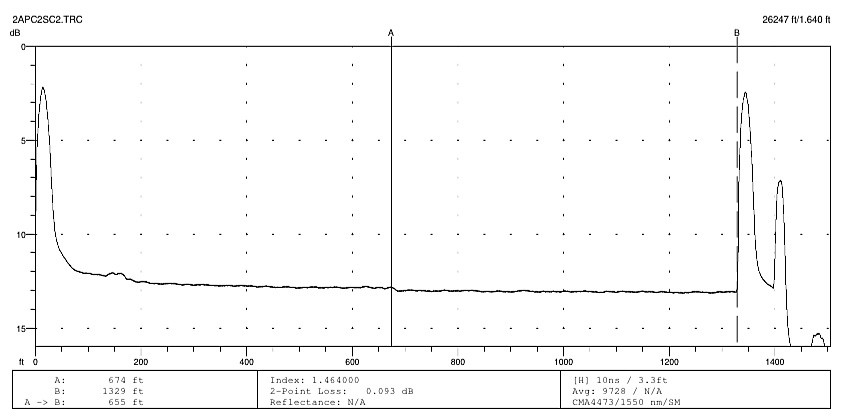
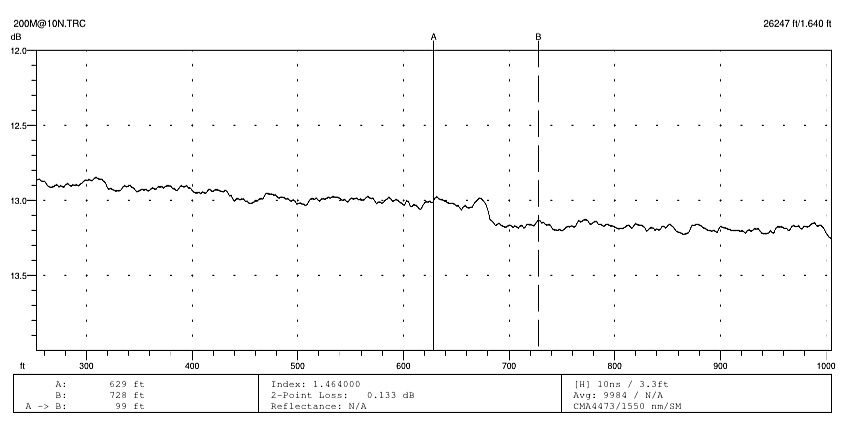
September 2022
Splicing Pigtails On A Cable
Q: I seem to be having an issue finding fiber protection sleeves
that can slide over the 3mm patch cable. I bought a sleeve that said it
with made for “single fiber fusion” but the thru hole which I would
side the cable thru prior to fusion is too small for the patch cable.
When I try and look on-line for specifications for the thru-hole size,
prior to fusion final melting of the glue in the sleeve, all I find are
post-melting diameters, none which are even close to being able to
handle the 3mm patch cable.
A: Splicing pigtails involves splicing the fibers only and the
cables are secured separately. The usual method of splicing on pigtails
is to splice the fibers and use the heat shrink tube to seal the splice
and the fibers from the outside air and protect it from stress. The
splice is placed in a splice tray. On either side, there is 2-3 feet of
fiber exposed from the cables being spliced. The splice tray has clamps
for all of the cables being spliced on the edges of the tray and the
fiber to the splice is coiled neatly on the splice tray. The jacket of
the pigtail is clamped at the edge of the splice tray but ends there,
so only fiber is coiled in the tray. If you try to coil fiber, the bulk
of the cable can get to be a problem where it’s coiled with the bare
fiber. You can get heat shrink protectors for fibers of 250 to 900 micron diameter buffers, but not for jacketed cables.
Important Questions From The Past
Managing And Maintaining a Fiber Optic Cable Plant During Its Lifetime.
Q: Are there guides / recommendations for optic fibre cable
life cycle management? (outside plant) including rehabilitation /
replacement timelines together with factors that may alter those
timelines ( such as seismic activity, extreme weather, human
activity-induced fibre cuts etc) also including typical performance
deterioration over the life cycle, and the performance levels at which
replacement / rehabilitation happens. Or does it happen (and is it
normally expected) that operators replace entire sections of fibre (say
400 km) as part of routine maintenance?
A: There is a saying here in the US that in fiber optics “the most common cause of failure is “backhoe fade” in underground cables
and “target practice” for aerial cables.” In other words, damage
caused by humans. We know of many fiber optic cable plants that have
survived natural disasters like earthquakes - in fact there is a lot of
work today using regular cables used in communications to monitor for
seismic activity. Fire can be a problem in remote areas, but often it’s
because the poles are burned causing the cables to fall.
Over the years we have questioned cable manufacturers about the lifetime
of fiber optic cable. They don’t like to make definitive statements but
we have been told that based on the cables installed in the past that
40 years is a probable lifetime for most cables. There are certainly
cables in use today that are over 30 years old already. The glass fiber
is not a problem, it’s the protection from the cables that will
eventually fail. Installation techniques can have an effect on the
longevity. For example splice closures should be sealed properly to
prevent ingress of moisture or dirt. Cables should not be installed with
bends below the rated bend radius or with excess tension.
FOA has always told users that fiber optic cables do not need maintenance (https://foa.org/tech/ref/user/maintain.html),
a response to some people advocating periodic inspection and cleaning
of connections, for example. That’s just more likely to cause damage.
When an accidental break in a cable occurs, we have guidelines for restoration (https://foa.org/tech/ref/restoration/rest.html), and planning for restoration when building the cable plant is very important.
Someday you will certainly want to replace cables, often well before the
lifetime of the cable, but generally because you need more fiber or the
older fiber will not support the network speeds you want for upgrades.
Planning for more fiber by installing more cables can be eased by
installing spare underground ducts when first installing cables - here
in the US, we call this “Dig Once” (https://foa.org/tech/ref/OSP_Construction/Underground_Construction.html). Testing fibers for higher speeds is called "fiber Characterization” (https://foa.org/tech/ref/testing/test/CD_PMD.html) and is routinely done when speeds above 10G or certainly 100G are considered for older fibers.
Knowing that the lifetime of fiber optic cable plants are ~40
years, it makes sense to plan ahead for future applications, installing
lots of fibers, leaving lots of open duct space and choosing network
architectures that will not obstruct upgrades. See the article on
Netly's network above.
Fiber Optic Color Codes Reference Chart
Q: Has anyone made a fiber optic pocket reference chart that has cable
color orders, frequencies, or other commonly used info on it?
A: The FOA has a page on its Online Guide that covers color codes
(https://foa.org/tech/ColCodes.htm). It is the most popular page in the
FOA Guide! It works great with a smartphone.

The
word on the "Dig Once" program is getting out - FOA
is getting calls from cities asking us for
information and advice. Here are some links:
The DoT page on the administration’s Executive
Order: http://www.fhwa.dot.gov/policy/otps/exeorder.cfm
And the
one to download and hand out:
A “How To” Guide from The Global Connect Initiative:
https://share.america.gov/wp-content/uploads/2016/04/6.-GCI-Dig-Once.pdf
Is There A Standard
For Fiber Optic Installation?
Another
question we get often is "Is there a standard for
fiber optic installation." The answer is yes, but
not from the usual standards groups you might
expect. Over 20 years ago, the National Electrical
Contractors Association (NECA) asked FOA to help
create a standard for installation. That standard,
ANSI/NECA/FOA-301 has been updated three times
already and is about ready for another update.
Unlike most of those groups who charge you a fortune
for standards, FOA covers the cost so ANSI/NECA/FOA-301
is available free from FOA.
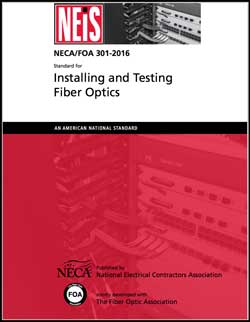
Download your free copy of ANSI/NECA/FOA-301
here (PDF)
Older
questions are now available here.
|
Training / FiberU
News and resources to help you learn more and stay
updated.
Find a
listing of all the FOA-Approved schools here.

Free online
self-study programs on many fiber optics and
cabling topics are available at Fiber U, FOA's
online web-based training website.
Free online training at
Fiber U
The FOA has >100
videos on  |
FOA School News
FOA's roster of approved schools is growing as more organizations
recognize our expertise in workforce development and our comprehensive
support for getting new schools started. FOA has over 25 years
experience and nearly 90,000 certified fiber techs (with ~120,000
certifications). As a non-profit organization founded by the industry
specifically to develop a competent workforce, FOA provides the
consultation, curriculum and contacts to get schools started as a free
service to new schools.
Welcome #5 in Ohio
This month FOA welcomes Washington County Career Center as our 5th
school in Ohio. Last year, the Governor's office held a formal ceremony
to announce the opening of a FOA school at Tri-County Career Center (FOA Newsletter September 2021.)
Washington County Career Center is the latest addition to the network
and two more are coming shortly. Soon Ohio will catch up with Kentucky
with 9 KCTCS schools in the FOA network.
Telecom Fiji
Andy Edwards of CommsLearning Limited emailed us as he was preparing to
head home to New Zealand that he had just spent time training personnel
at Telecom Fiji - 55 CFOT’s trained, 6 Designers and 4 instructors who
can deliver CFOT
internally with certifications going via
CommsLearning. Details above.
FOA Network Of
Approved Schools Continues To Grow
The
need for more fiber optic networks to support
fiber broadband and wireless/5G networks has led to a
strong demand for more trained and FOA-certified
techs, and that has led to a demand for more
training organizations. FOA has been adding new
schools and certifying new instructors to meet the
demand.
Schools added
recently:
School 775 INCITEL-UNI Lima Peru
School 406 Fiber Cert Santa Barbara, CA
School 404 Artison Technical Services, Waldorf, MD
School 403: Washington County Career Center
School 774: Arrow For Engineering, Amman, Jordan
School #401: Western Wyoming Community CollegeSchool 399: Team Fishel, Virginia
School 398, Telecom Tech, Colorado
School 396 Optconn, Boston, MA
School 395 Fiber Wizards
(Knowledge on Demand LLC)
School 393,
Carolina's Solution Group
School 394,
Tri-County Career Center, Nelsonville, Ohio
School
388: Global Com of Sterling, Virginia, USA
School 389. CWA-JATC Telecom Training Center, San
Jose, CA
School 390 Northern Allied Communications,
Nespelem, WA
School 391 Lewis-Clark State College,
Lewiston, ID
School 392 Wallace Community College, Dothan,
AL
Complete listing of FOA Approved Training Organizations
Need A Fiber Optic Course Onsite? Invite an FOA School To Come To You
FOA often gets inquiries from an organization that
has personnel that needs training in fiber optics. Recent inquiries have
included contractors, a manufacturer of high-reliability products using
fiber optics and a cable manufacturer. In many cases, where there are
several people needing training, FOA can recommend a FOA Approved School
and Certified Instructor who will come to their location to teach a
class. The advantage is of course the savings in travel costs if
the class comes to you, but it also offers the opportunity to customize
the course to fit your needs, even use your equipment or work on your
components, so the training is more relevant to those taking the class.
Contact FOA to discuss the idea of a custom, on-site class to see if it will better meet your needs.
Fiber U
On-The-Job Training (OJT) Program
The
FOA Fiber U OJT program for novices combines online study at
Fiber U with OJT with mentoring by experienced
co-workers and their supervisor to help new employees
develop into FOA-certified technicians in only
one year.
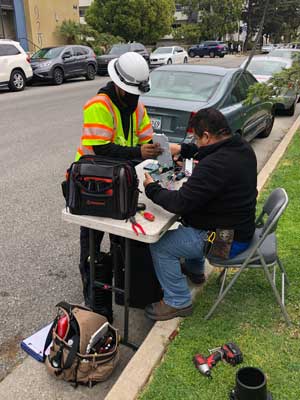
The FOA Fiber U “OJT-To-Cert”
program includes both fiber optics
and premises cabling (copper, fiber & wireless),
so it covers techs working in both outside plant and
premises jobs.
Like other FOA
programs, the OJT-To-Cert program is free. If you
and/or your company is interested in the FOA
OJT-To-Cert program,
contact FOA.
To explain how OJT
works and FOA's OJT-To-Cert program, FOA created a
short video: Lecture 62: On
The Job Training For Fiber Optics Using Fiber
U
FOA
Direct Certification Program For Experienced Fiber Optic Techs
Experience Plus
Online Study At Fiber U = FOA Certification
Experienced fiber optic technicians can become FOA Certified using
their experience in fiber optics and study for the
FOA certification exams online at Fiber U. Thousands of
industry professionals have applied to the FOA
directly for certification without the need for
classroom training, based on their knowledge and
skills developed working the field. Since FOA
certifications are based on KSAs (knowledge, skills
and abilities), current techs can show the
skills and abilities required through their field
experience. FOA provides free online self-study courses at Fiber U for the knowledge
part to prepare you for FOA certification exams
which you can also take online.
If you are an experienced field tech interested in
certification, and FOA is the internationally
recognized certifying body for fiber optics, you can
find out more about the FOA Direct Certification Program
here.
If you are already a CFOT, FOA also offers many
specialist certifications you can obtain based on
your experience as a field tech. See what's
available at Fiber
U.

Fiber U "Basic Fiber
Optics" Online Self-Study Course Now In Spanish
El curso de
autoaprendizaje en línea "Fibra óptica básica" de
Fiber U ahora en español
El sitio de
aprendizaje en línea de FOA, Fiber U, tiene más de
dos docenas de cursos de autoaprendizaje gratuitos
sobre fibra óptica y cableado de instalaciones.
Como era de esperar, el tema más popular es el
curso "Fibra óptica básica", que se utiliza para
iniciarse en la fibra óptica y como curso de
preparación para realizar el examen de
certificación FOA CFOT.
Ahora el curso básico
de fibra óptica está disponible en español,
utilizando el libro de texto FOA en español, la
sección de la Guía en línea en español y la
capacidad de YouTube para traducir subtítulos de
video al español. El curso funciona exactamente
como la versión en inglés con 10 lecciones, cada
una con cuestionarios y una opción para tomar un
examen de Certificado de finalización.
Para presentar el nuevo curso de
español Fiber U, el examen Certificate of
Completion es gratuito, así que dígaselo a sus
contactos.
Curso Básico de Fibra Óptica
de Fibra U en español.
New Fiber U Course: Fiber Characterization
FOA has added a new course at Fiber U on Fiber Characterization. Fiber
characterization is the process for testing long fiber cable plants for
its ability for carrying high speed communications. With so many
networks now operating at 100, 200, 400 or even 800 Gb/s, fiber
characterization is important, especially on older fiber optic cable
plants.The free Fiber U Fiber Characterization course is available in two forms, as a standalone Fiber U fiber Characterization Course with its own Fiber U Certificate of Completion and as a separate Lesson in the Fiber U Fiber Optic Testing course. This course is recommended for those studying for the FOA CFOS/FC Fiber Characterization certification.
Fiber U MiniCourses: Got An Hour Or Less?
Learn Something New About Fiber Optics.
FOA
has introduced a new type of Fiber U
course, the MiniCourse, a free online course you
could take in a short time, perhaps as you ate lunch
at your desk or took a coffee break. The
topics of these courses should explain what they are
about, and these are all very important topics to
fiber optic techs.
Fiber Optics In Communications
How Optical Fiber Works
Fiber Optic Network
Restoration
Fiber
Optic Connector Identification
Fiber U Color Codes
The Mysterious
dB of Fiber Optics
Fiber Optic Cable Bend Radius
Fiber Optic Link Loss And Power
Budgets
Fiber Optic Connector
Inspection And Cleaning
Fiber Optic Media Conversion
Fiber Optic Cable Midspan Access
Reading An OTDR Trace
Reference Cables For Testing
Fiber Optic Attenuators
The courses have two components, video lectures and
readings, that are complementary. As usual there is
a self-test to allow you to check your
comprehension. As with other Fiber U courses if you
desire, you can take a short test for a Fiber U
Certificate of Completion that costs
only $10.
All these free courses and many more
are available at Fiber U.
What Fiber Techs
Don't Know -
What We Learn From
FOA Certification Tests
As
FOA moves more testing over to our digital online
testing system at ClassMarker, we have access to
more data about our testing, including what
questions and topics on the tests are answered
incorrectly most often. Having this data gives us an
opportunity to evaluate the questions and how they
are stated, but more importantly it allow us to help
our instructors teach the subjects and us to change
our curriculum and online courses to emphasize these
particular topics. These are some of the topics that
we have noticed are answered incorrectly more often
in FOA and Fiber U tests.
Most of the questions missed are on testing.
1. OTDRs - particularly what information is in the
OTDR trace.
2. The difference between dB and dBm
3. Loss budgets - both the concepts and doing the
math
4. Insertion loss testing - single-ended or double
ended for testing patchcords or cable plants, how to
set 0dB references
5. Units of measure - fiber is measured in microns,
wavelengths in nanometers, etc.
At FOA, we're working to add Fiber
U MiniCourses on these topics and working with
our schools to emphasize these topics in their
classes.
If you are going to be taking a FOA certification
course or test in the near future, these topics
should be on your final exam study list.
What We Learn From Hands On Labs
We learn about students performance in hands-on labs
from the feedback of our instructors and our own
experiences too. One big problem is the use of hand
tools. Growing up today, you learn how to use
keyboards, mouses and touch screens, but decades
ago, you also learned how to use basic hand tools.
This is big enough of a problem that we're
considering adding some video lessons on basic hand
tools to prepare students for cable prep,
termination and splicing that require the use of
hand tools.
FOA Guide "Basics Of
Fiber Optics" Now Available Online in Portuguese
(6/2020)

FOA
has now translated the Basics of Fiber Optics
textbook in our Online Guide into Portuguese,
joining Spanish and French translations. For those
speaking Portuguese, we have the technical
information and for schools we also have curriculum
available.
Here is the FOA
Guide in Portuguese,
Spanish
and French
translations.
Time
To Learn - Online
Some
schools have been closed during the pandemic, so FOA
has been working with them to create new online
learning experiences that can in some cases lead to
certification online. FOA certifications are still
based on the KSAs - knowledge from the classroom,
skills from the labs and abilities judged by
instructors or proven by actual experience.
ZOOMing
Much of what we're doing benefits from the
capabilities of "Zoom." Others have created
videoconferencing apps, but none work so well,
especially with limited bandwidth. We've seen remote
labs that have an instructor showing students how to
use the tools they were sent then watching them
duplicate their actions. We have worked out methods
to use Zoom to proctor FOA's online certification
exams.
Blended
Learning
While most FOA schools have suspended in-person
training during this period, some are offering a
"blended learning" option. That means that
students sign up for a FOA certification course,
take the classroom sessions on Fiber U with the
assistance of a FOA certified instructor. Now
online instruction can include reviewing the
labs using the Fiber U Basic
Skills Labs, then when it's possible to attend
classes at the school, complete the hands-on
labs and take the FOA certification exam.
Online Remote Labs
Alternatively, some schools are experimenting
with "remote labs," where the students get
sent tool kits and components and labs are
conducted by videoconferencing. Before the
labs, the students may watch demos by their
instructor on videoconferencing and/or review
the relevant "virtual hands-on" lessons in the
Fiber U Fiber Optics Basic Skills Labs
so they will already know the steps in the
exercises. And Fiber U has
the new Fiber U
DIY Basic Skills Lab lesson
with directions on how to
purchase inexpensive tools
online and use them to learn
basic fiber optic skills. Videoconferencing
allows the instructor to remotely monitor
their work and provide help as needed. Contact
the FOA for more information.
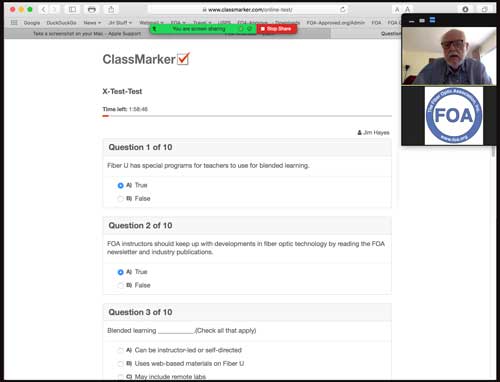
FOA Zoom Exam Proctoring
Online
Certification Testing
FOA has all its certification tests
available online, both for use by our
schools and by our direct "Work
to Cert" applicants. All FOA
certification tests require a proctor to
oversee the applicant taking the exam. In
this time of social distancing, getting a
proctor can be difficult, so FOA now has
procedures for online proctors
administering the exam. Contact
the FOA for more information.
OJT - On-The-Job-Training
Many novices get a job and learn on the job.
They usually have an experienced tech who helps
them gain the knowledge and learn the
skills they need to perform their job. Thinking
about this in relation to the FOA KSAs,
the knowledge, skills and abilities needed by a
fiber optic tech, the tech will learn
skills but not the basic knowledge that helps
them understand the processes involved. FOA can
offer help here with our FOA's
OJT-to-Cert Program,
using our Fiber
U online self-study programs. While the
tech learns on the job, they become a Fiber
U trainee, getting the knowledge they
need, while working under their "mentor" at
work. This is particularly good for
contracting companies who need techs but do
not have the usual training courses
available. Interested in OJT programs? Click
on the link below or contact FOA for
more information.
FOA's OJT-to-Cert
Program

FOA offers free online self-study programs at Fiber U.
Many users are preparing for FOA certification
programs - taking courses at our schools or using
the "Work-to-Cert" program. Some of our
schools are requiring Fiber U programs as
prerequisites for their classroom courses so they
can spend more time on hands-on activities.
FOA School Offers
Toolkit With Online Training

Slayton Solutions
(FOA Approved School #156) is offering a simple
fiber optic tool kit that includes a 29-piece set
of fiber optic tools and a power meter along with
training videos and online instruction for only
$499. 29 Piece Kit includes all tools and devices
a technician needs to install fiber optic
connectors and test optical power. You can contact them for
more information at slaytonsolutions@sbcglobal.net
or https://www.fiberopticsinstitute.com
|
Publications /
Resources

|
Cross Reference To FOA Tech Materials
FOA has so much technical reference material, we created a cross reference guide to the textbooks,
Online Guide and Fiber U courses, all the FOA technical information.
Besides the textbooks, online Guide and Fiber U, each section of the
Guide also includes links to the 100+ FOA videos available.
Cross Reference Guide to Textbooks, Online Guide and Fiber U
FOA Guide To Fiber Optic Workforce Development
To help those new to fiber optic workforce development, FOA has created a web page we call "Fiber Optic Workforce Development."
In this page, we share what we have learned about the fiber optic
workforce, who they are and how they learn their trade. We discuss what
defines a fiber optic tech and how they should be certified.
Read the FOA Guide To Fiber Optic Workforce Development online.
Latest FOA Book: Fiber Broadband (Paperback and Kindle)
 In less than half a century,
fiber optics has revolutionized communications and to a large extent,
society in general. Broadband, what many today call high speed Internet
access, has become a necessity for everyone, not a luxury. The
technology that makes broadband possible is fiber optics, connecting the
continents, cities, and just about everybody. Even fiber to the home
(FTTH) brings broadband to hundreds of millions worldwide. In less than half a century,
fiber optics has revolutionized communications and to a large extent,
society in general. Broadband, what many today call high speed Internet
access, has become a necessity for everyone, not a luxury. The
technology that makes broadband possible is fiber optics, connecting the
continents, cities, and just about everybody. Even fiber to the home
(FTTH) brings broadband to hundreds of millions worldwide.
How did we get from an era when communications was making a telephone
call or sending a telegram to today’s world where every piece of
information – and misinformation – is available at the click of a mouse
or touch on a screen? How did we get from a time when a phone was
connected on copper wires to being able to connect practically anywhere
on a handheld device with more computing power than was available to
scientists and engineers only decades ago?
How does broadband work? Without fiber optics it would not work.
This book is not the typical FOA technical textbook - it is written for
anyone who wants to understand fiber broadband or fiber optics or the
Internet. It's also aimed at STEM teachers who want to include
communications technology in their classes. This book will try to
explain not only how fiber broadband works, but how
it was developed. It is intended to be an introduction to
communications technology
appropriate for a communications course at almost any level (junior
high, high school or
college,) for managers involved with broadband projects, or for anyone
who just wonders how all this stuff works.
The Fiber Optic Association Guide To Fiber Broadband
Paperback ($12.95) and Kindle ($9.95) versions available from Amazon or most booksellers. Kindle version is in color!
More Translations of FOA Textbooks
 FOA is a very international organization and it works hard to
accommodate the language needs of everyone. We have been translating our
books and website into the languages most requested, and this month, we
add two more textbook translations. We also want to thank Jerry Morla,
FOA CFOS/I instructor and Director who has been doing the recent
translations into Spanish, his native language. FOA is a very international organization and it works hard to
accommodate the language needs of everyone. We have been translating our
books and website into the languages most requested, and this month, we
add two more textbook translations. We also want to thank Jerry Morla,
FOA CFOS/I instructor and Director who has been doing the recent
translations into Spanish, his native language.
Here is a listing of all the FOA textbook Translations
Spanish Editions:
Guía de Referencia de la Asociación de Fibra Óptica (FOA) Sobre Fibra
Óptica: Guía de estudio para la certificación de la FOA Amazon
La Referencia de Cableado para Predios de la FOA: Guía para Certificación de la FOA Amazon
La Asociación de Fibra Óptica Manual de Fibra Hasta el Hogar : Para
Planificadores, Gestores, Diseñadores, Instaladores y Operadores De
FTTH Amazon
Guía de Referencia de la FOA sobre Diseño de la red de fibra óptica: Guía de Estudio para la Certificación de la FOA Amazon
And the FOA Reference Guide To Fiber Optics:
French Edition: Le
Guide de référence de la FOA pour la fibre optique et et
guide d'étude pour la certification FOA: Guide d'étude pour
la certification FOA Amazon
Portuguese Edition: Guia de Referência sobre Fibra Óptica da FOA : Guia de Estudo para a Certificação da FOA Amazon
The subject matter of these books is also translated in the FOA Guide online.
Planning A Fiber Optic Project?
The FOA Guide To Fiber Optic Projects includes this timeline and comments on project planning and implementation.
More New FOA Video
Lectures On YouTube
Did you know YouTube
will close caption videos in many languages?
Here are directions.
FOA Lecture 73, The History of Fiber Optics - A Timeline fiber optics from the beginning.
FOA YouTube Video Describes
On-The-Job Training (OJT)
FOA Lecture 67 Fiber Optics At
Electrical Utilities
More New Videos
Including FTTH Series
Like all our YouTube lectures, they are
all short and easy to understand.
Did
you know YouTube will close caption videos in many
languages?

Sign in with Google to get translations for closed
captioning. Click on the settings icon (red arrow.)
Choose "Subtitles". English is the default
language. Click on the arrow after "English
(auto-generated) >". In the new window click on
"Auto-translate" and choose the language you
want.
FOA Loss Budget
Calculator On A Web Page 5/2020
FOA
has written many articles about loss budgets,
something everyone involved in fiber optics needs to
know and needs to know how to calculate. We recently
discovered how to get a spreadsheet ported to a Web
page, so we created this web page that calculates
loss budgets. We have an iOS loss budget app, but
with this web page, you can calculate loss budgets
from any device, smart phone, tablet, laptop, or
desktop computer that has web browsing capability.

Bookmark this page (especially on your
smartphone): FOA Loss Budget Calculator
Online
 We are continually updating the Online Reference
Guide to keep up with changes in the industry and
adding lots of new pages of technical information.
When you go to the FOA
Guide Table of Contents to see the latest
updates - look for
We are continually updating the Online Reference
Guide to keep up with changes in the industry and
adding lots of new pages of technical information.
When you go to the FOA
Guide Table of Contents to see the latest
updates - look for  . .
Recent updates:
FTTH
Updates: Added a section on FTTH Network Design,
updated Architecture and PONs (10G)
Color Codes For Fiber Optics
Includes print your own pocket guide and versions for your smartphone.
Fiber
Optic Projects - the FOA Guide to projects from
concept to operation
Coherent Communications Systems in
the FOA Guide.
Go
to The FOA Online Fiber Optic
Reference Guide.
FOA Reference Books
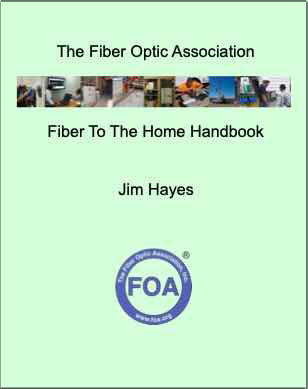
FOA's FTTH Handbook: We've
gathered all our information on FTTH from the FOA
Guide and past issues of the FOA Newsletter and
edited it into a 112 page "FTTH Handbook." We even
added a section on planning and managing FTTH
Projects.
The Fiber Optic Association
Fiber To The Home Handbook is
available from Amazon in print and Kindle
editions.
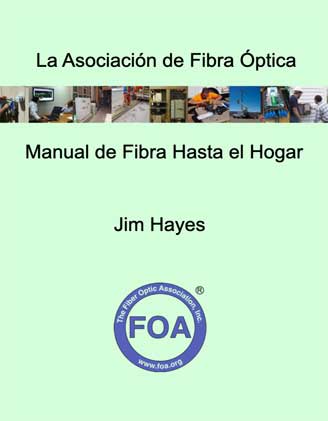
Sitio web y manual de FTTH ahora en español
Sitio web y manual de FTTH ahora en español - FTTH Website And Handbook Now In Spanish
El Manual FOA FTTH se ha convertido en el libro FOA
más vendido y tiene una calificación de 4.7/5 por parte de los
compradores en Amazon.
FOA ha notado mucho interés en FTTH en otras áreas del mundo,
especialmente en América Central y del Sur, por lo que tradujimos el
sitio web de FTTH y el Manual de FTTH al español.
Available in paperback from Amazon or ebook on Amazon Kindle.
Disponible como libro de tapa blanda en Amazon o como libro electrónico en Amazon Kindle.
El sitio web de FOA FTTH ahora en español.
El Manual FOA FTTH se ha convertido en el libro FOA
más vendido y tiene una calificación de 4.7/5 por parte de los
compradores en Amazon.
FOA ha notado mucho interés en FTTH en otras áreas del mundo,
especialmente en América Central y del Sur, por lo que tradujimos el
sitio web de FTTH y el Manual de FTTH al español.
Disponible como libro de tapa blanda en Amazon o como libro electrónico en Amazon Kindle.
El sitio web de FOA FTTH ahora en español.
 
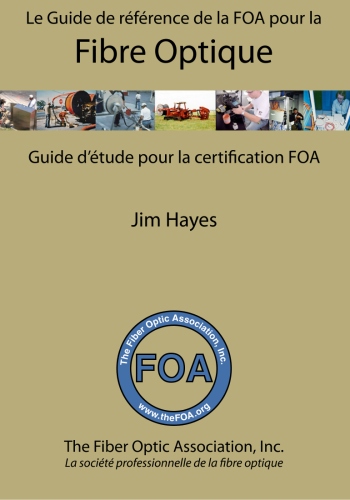      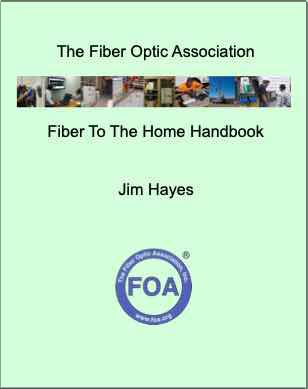
Fiber Optics (4 languages), Premises Cabling, OSP
fiber and construction, Network Design, Testing and
FTTH
The FOA has it's own
reference books for everyone working in fiber
optics - contractors, installers and end users as
well as for use as textbooks in classes at
educational institutions. They are available as
printed books or Kindle at much lower prices than
most textbooks since we self-publish and sell
online, cutting out the middlemen. Click on the
book images for more information. The Reference
Guide To Fiber Optics is also available in
Spanish, French and Portuguese. The Design book is available in English
and Spanish.
Click on any book for more information
about it.
FOA
has reprinted

"Lennie Lightwave's Guide"
on its 25th anniversary in a special print
edition.
Lennie
and Uncle Ted's
Guides are online or as free iBooks on iTunes.


Click on any of
the books to learn more.
- Fiber
Optic Safety Poster to download and
print
Resources For
Teachers In K-12 And Technical Schools
Teachers in all grades can introduce their
students to fiber optic technology with some
simple demonstrations. FOA has created a page for
STEM or STEAM (science, technology, engineering, arts
and math) teachers with materials appropriate to
their classes. Fiber Optic Resources For
Teachers.
|
Safety
|
On Safety
The FOA is concerned about safety!
FOA
considers safety an integral part of all our
programs, curriculum materials and technical
materials. We start all our textbooks and their
online versions with a section on safety in the
first chapter, like this: Before
we get started - Safety First!
There are pages on the FOA Guide on Safety
procedures Including Eye Safety and. Digging
Safely
And a YouTube lecture: FOA Lecture 2: Safety When Working
With Fiber Optics
In our OSP Construction Section, these pages cover
many safety issues including those related to the
construction of the cable plant: Project Preparation And Guidelines,
Underground Cable Construction,
Underground Cable Installation
and Aerial Cable Installation.
There is even a safety poster for the fiber
activities: PDF Safety Rules For Fiber Optics
Other Safety Resources:
There is a toll-free
"call before you dig" number in the USA: Dial 811. See www.call811.com
for more information in the US. Here is their map of resources by states.
In Canada, it's "Click Before You Dig.com" They also have a page of resources by US states and Canadian provinces.
The Common Ground
Alliance has an excellent "Best Practices Guide"
online
- The US Department
of Transportation has a website called "National
Pipeline Mapping System" that allows one
to search for buried pipelines.
Why We Warn You To
Be Careful About Fiber Shards
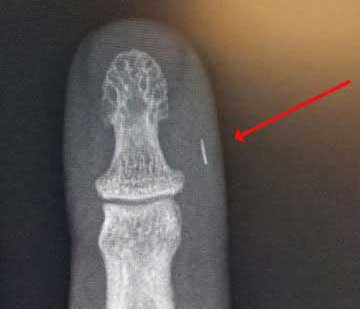
Photo courtesy Brian Brandstetter,
Mississauga Training Consultantcy
2023 Conference On
Damage Prevention In Tampa

Global Excavation Safety Conference Tampa, Florida
February 14-16, 2023
GlobalExcavationSafetyConference.com:
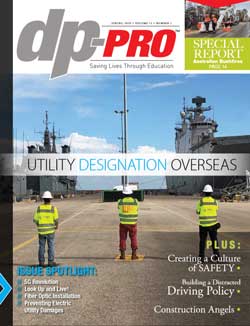
The magazine, dp-Pro, sponsor of the conference,
has also published it's latest issue with an
article by FOA on "New Construction Techniques
in Fiber Optics" and a overview of the FOA. You can read the magazine here.
When You Bury Marker
Tape, Bury One That Will Work (July 2021)
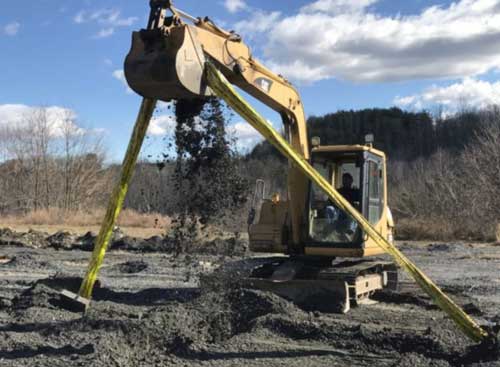
Signaltape® provides a visual
warning by ensuring tape is brought to the surface,
alerting the operator to the presence of a buried
utility. It includes a 3,000-lb. tensile strength
aramid fiber membrane, which ensures the tape is
pulled to the surface to alert the excavation crew.
Signaltape
comes in two sizes: 12″ x 1000′ or 6″ x
1000′.
FOA
Corporate Members - Products & Services
List
of corporate member information provided by FOA
corporate members listed on the FOA website.
|
FOA/About
About The FOA
- Contact
Us: http://www.foa.org
or email <info@foa.org>

FOA has a company page
and four LinkedIn Groups
FOA
- official company page on LinkedIn
FOA
- covers FOA, technology and jobs in the fiber optic
marketplace
FOA
Fiber Optic Training - open to all, covers
fiber optic technology and training topics
Grupo de La Asociación de
Fibra Óptica FOA (Español)
|
What is The FOA?
The FOA is a, international non-profit
educational association chartered to promote
professionalism in fiber optics through education,
certification and standards.
Founded in 1995 by a dozen prominent fiber optics
trainers and leaders from education, industry and government as a professional society for fiber
optics and a source of independent certification,
the FOA has grown to now being involved in numerous
activities to educate the world about fiber optics
and certify the workers who design, build and
operate the world's fiber optic networks.
Read More
FOA History
FOA Timeline of Fiber Optics
Contact
Us
The Fiber Optic Association Inc.
https://www.foa.org or email
<info@foa.org>
https://www.thefoa.org or email <info@thefoa.org>
Telephone/text: 760-451-3655
The
FOA Home Page

Want to know more about fiber optics? Study
for FOA certifications? Free
Self-Study Programs are on "Fiber U®."
Looking for specific information? Here's the largest
technical reference on the web: The
FOA Online Fiber Optic Reference Guide.

Free online self-study programs
on many fiber optics and cabling topics are
available at Fiber U,
FOA's online web-based training website.
|
-
Contact Us
The Fiber Optic Association Inc.
The FOA Home Page
Fiber Optic Timeline
(C)1999-2023, The Fiber Optic Association, Inc.
|
FOA Logo
Merchandise
New FOA Swag! Shirts,
Caps, Stickers, Cups, etc.
The
FOA has created a store on Zazzle.com offering lots
of new logo merchandise. It has lots of versions of
shirts and other merchandise with "FOA," "Fiber U,"
"Lennie Lightwave" designs and more so you should
find something just for you! See FOA on Zazzle.
-

Your
Name, CFOT® - It pays to advertise!
The FOA encourages
CFOTs to use the logo on their business cards,
letterhead, truck or van, etc. and provides logo
files for that purpose. But we are also asked
about how to use the CFOT or CFOS certifications.
Easy, you can refer to yourself as "Your Name,
CFOT" or "Your Name, CFOS/T" for example.
Feel free to use the
logo and designations to promote your achievements
and professionalism!
Contact
FOA at info@thefoa.org to get logos in file format
for your use.
Privacy Policy (for
the EU GDPR): The FOA does not
use cookies or any other web tricks to gather
information on visitors to our website, nor do
we allow commercial advertising. Our website
hosts may gather traffic statistics for the
visitors to our website and our online testing
service, ClassMarker, maintains statistics of
test results. We do not release or misuse any
information on any of our members except we will
confirm FOA certifications and Fiber U
certificates of completion when requested by
appropriate persons such as employers or
personnel services.
Read
the complete FOA Privacy Policy here.
|












































.jpg)






 OptConn
is a value-add re-seller of optical connectivity products, services and
solutions. With over 30 years of experience in the fiber optics
industry we are here to serve your requirements from fiber optic
training with FOA certification to products, materials and supplies.
OptConn
is a value-add re-seller of optical connectivity products, services and
solutions. With over 30 years of experience in the fiber optics
industry we are here to serve your requirements from fiber optic
training with FOA certification to products, materials and supplies. 























 .
.







